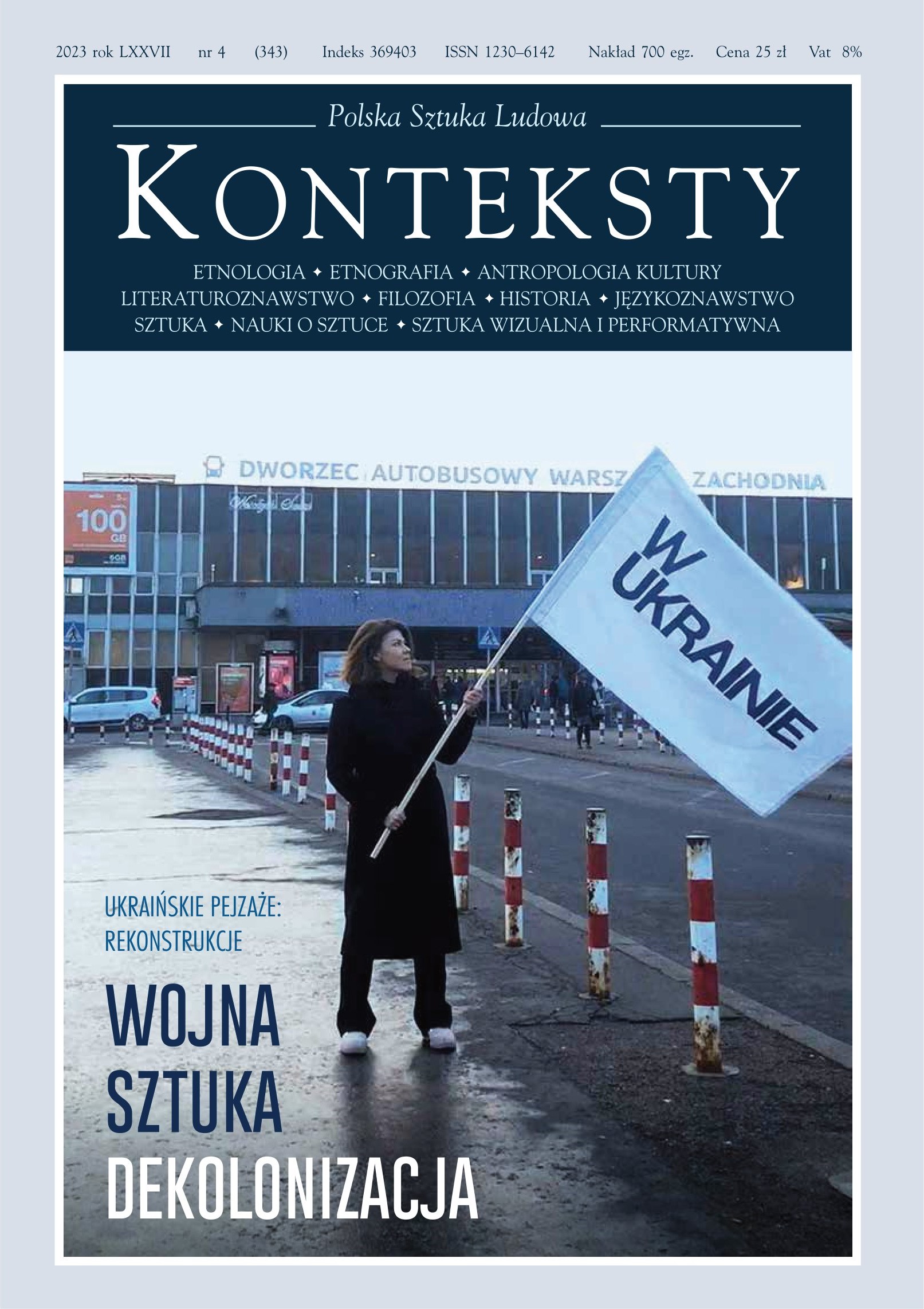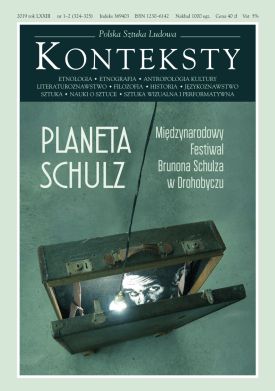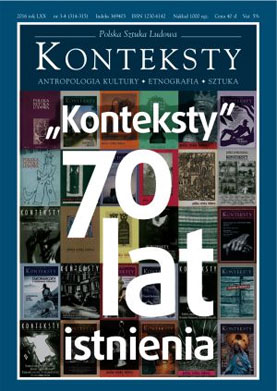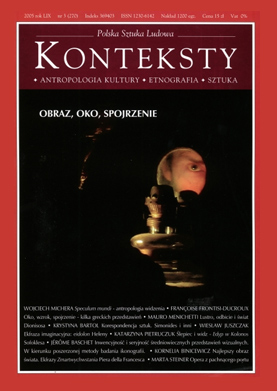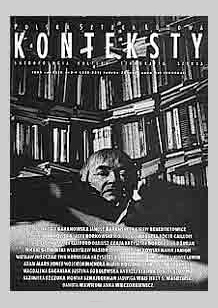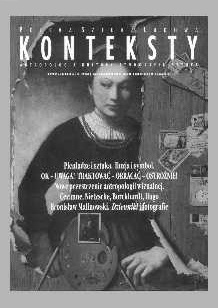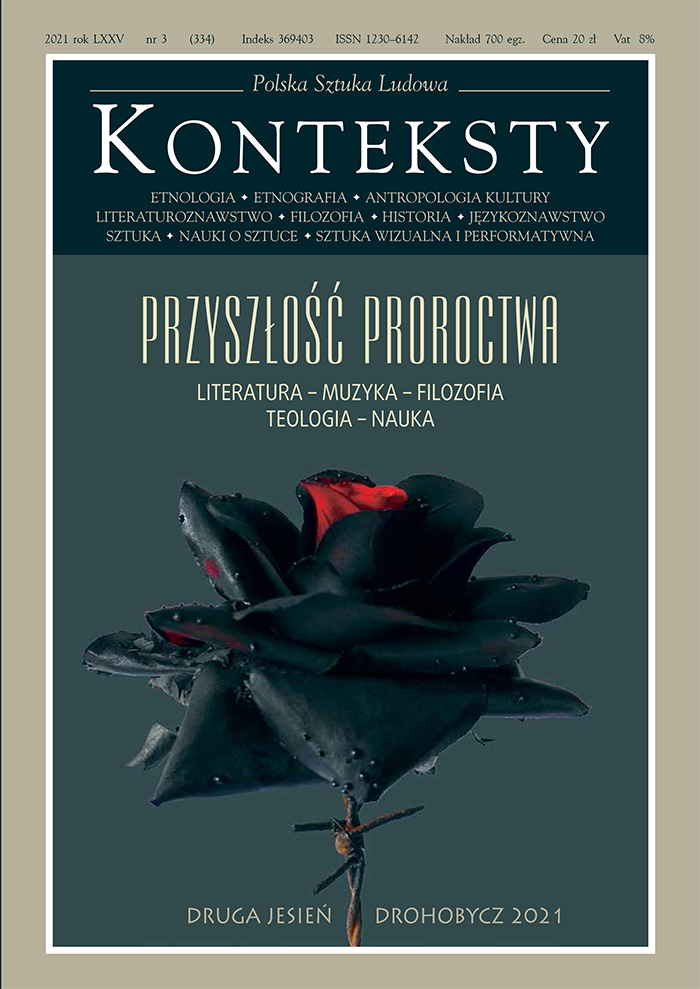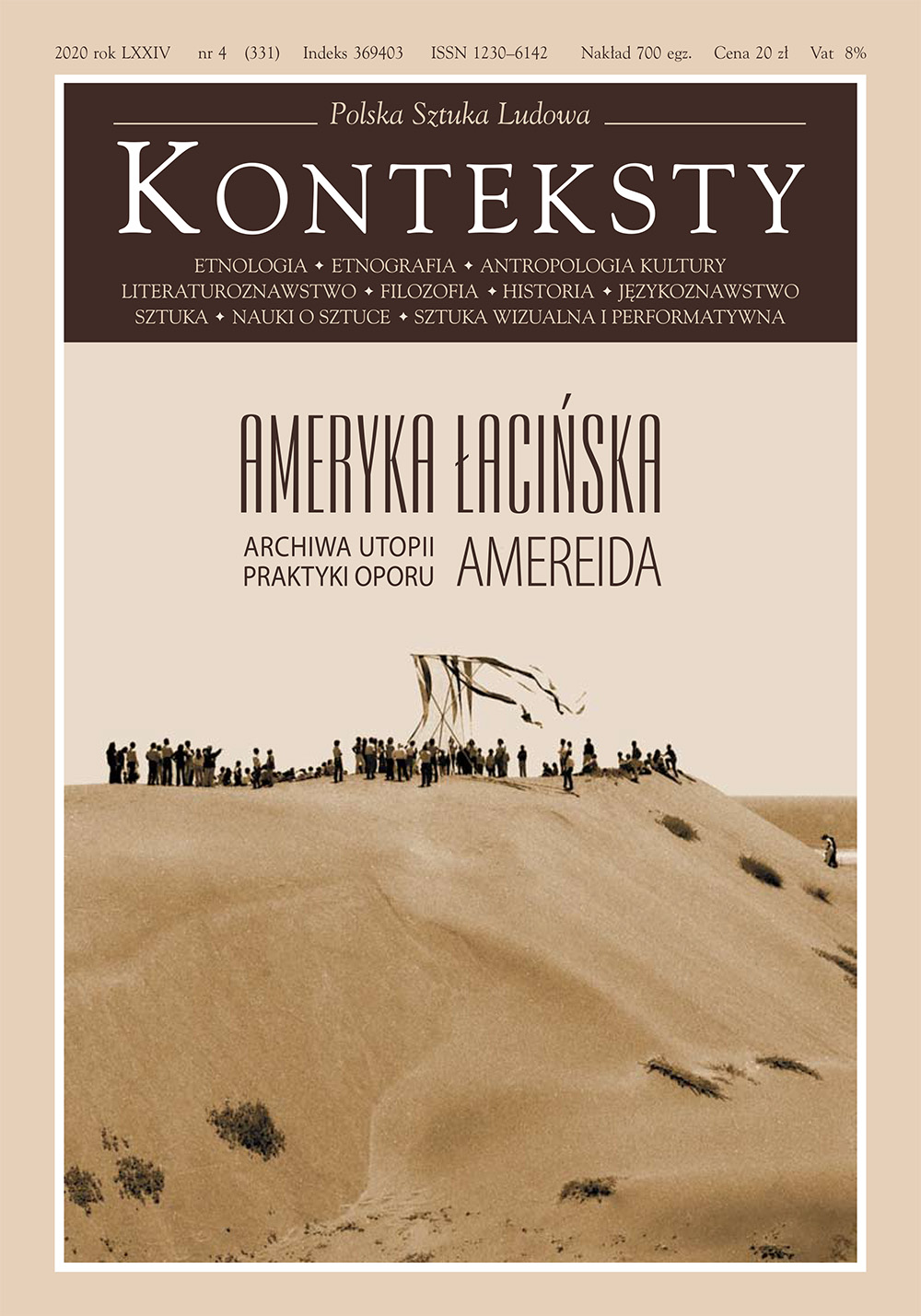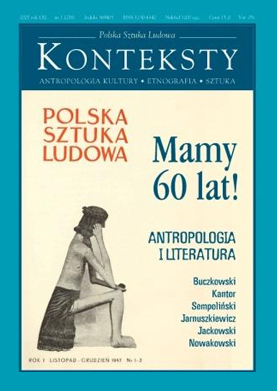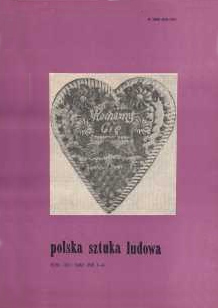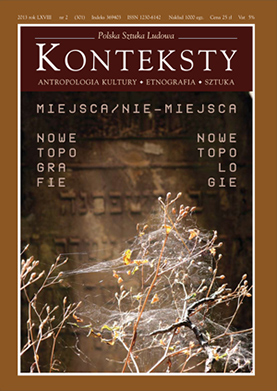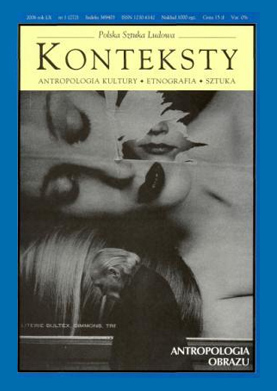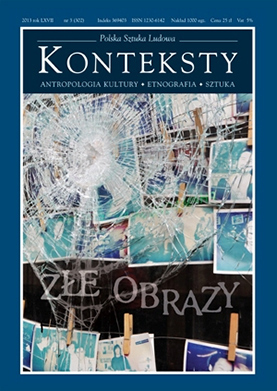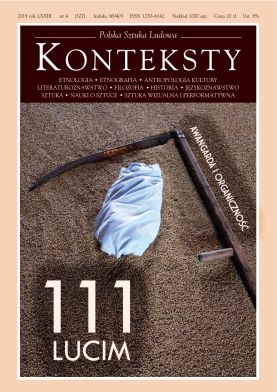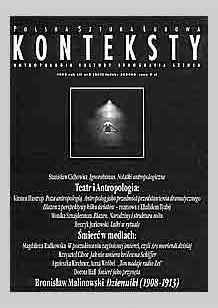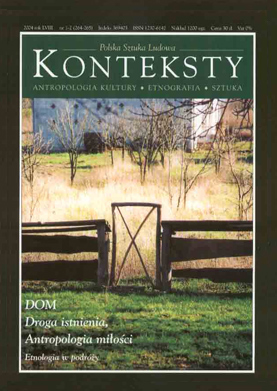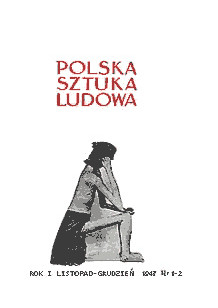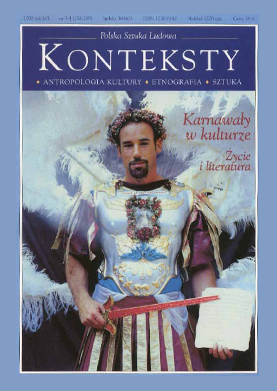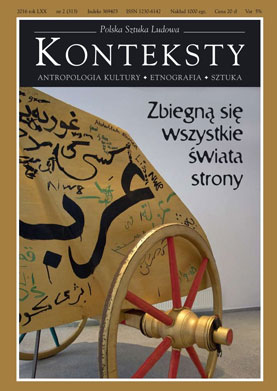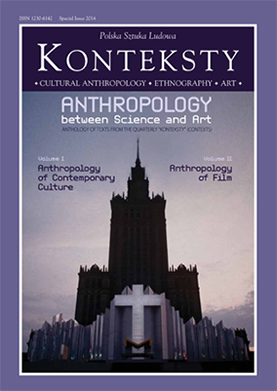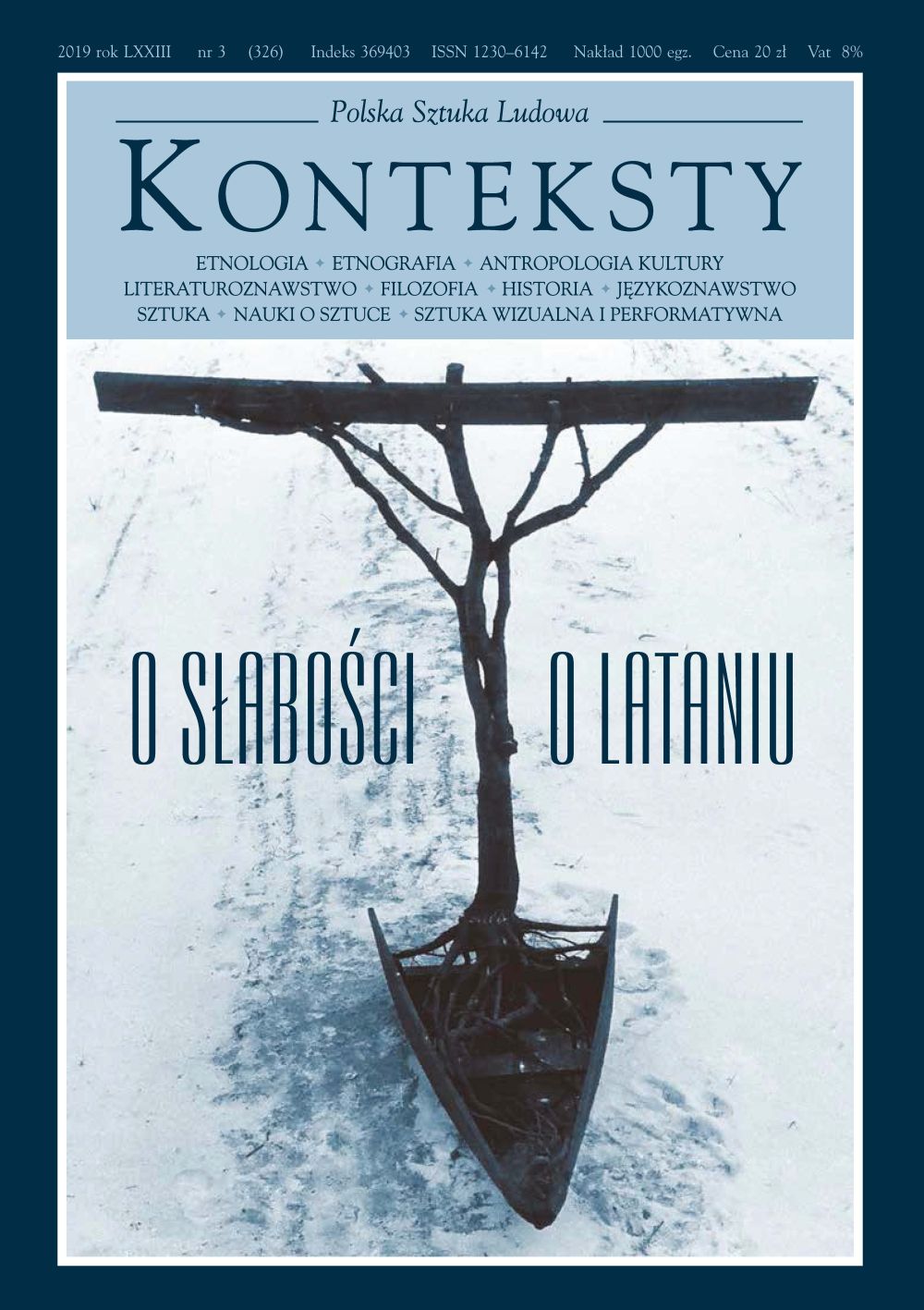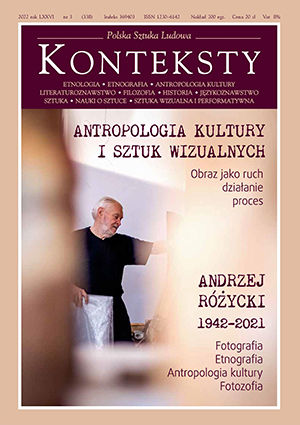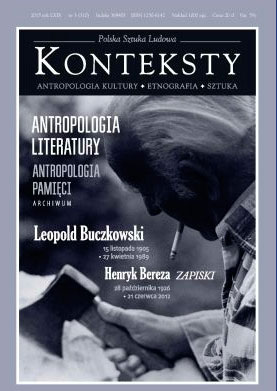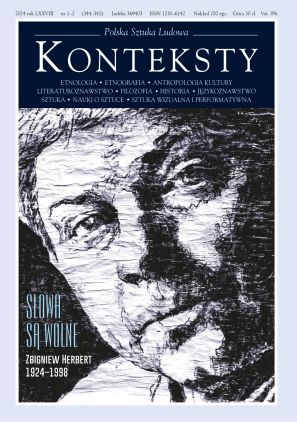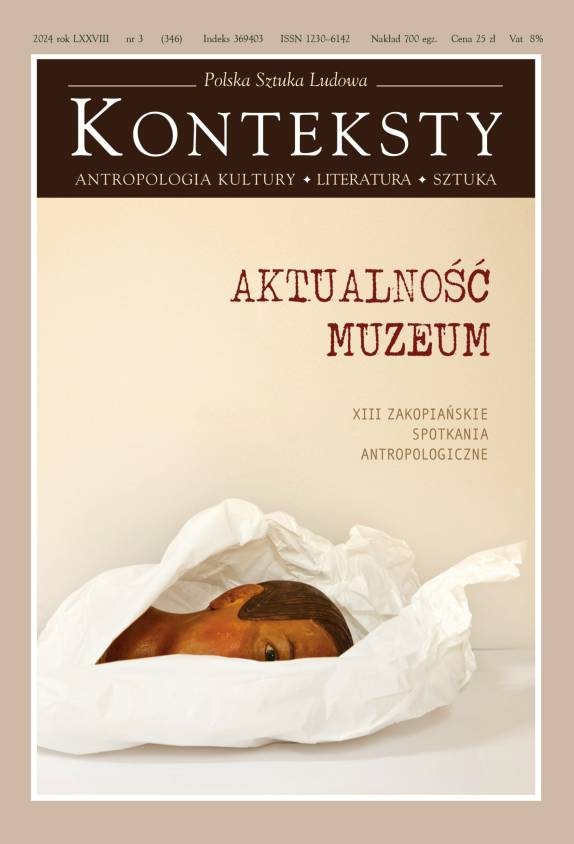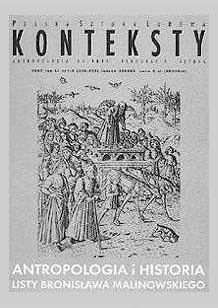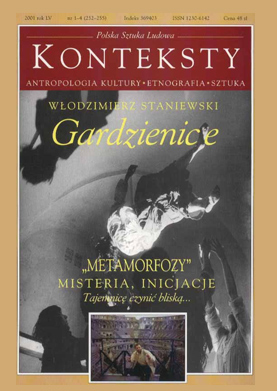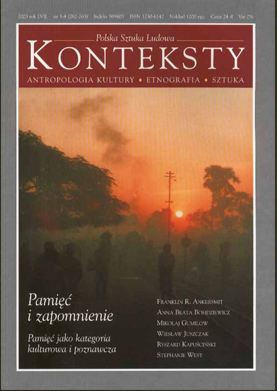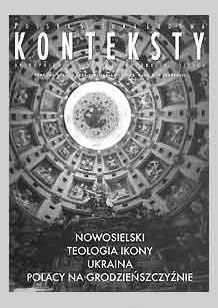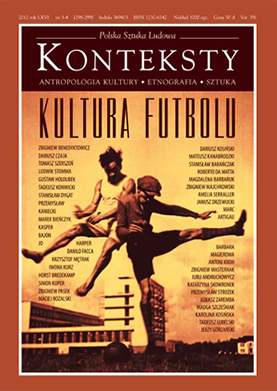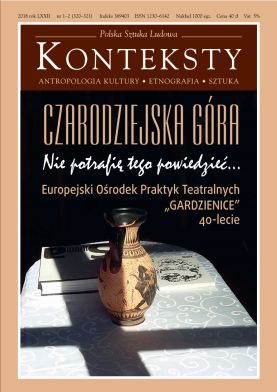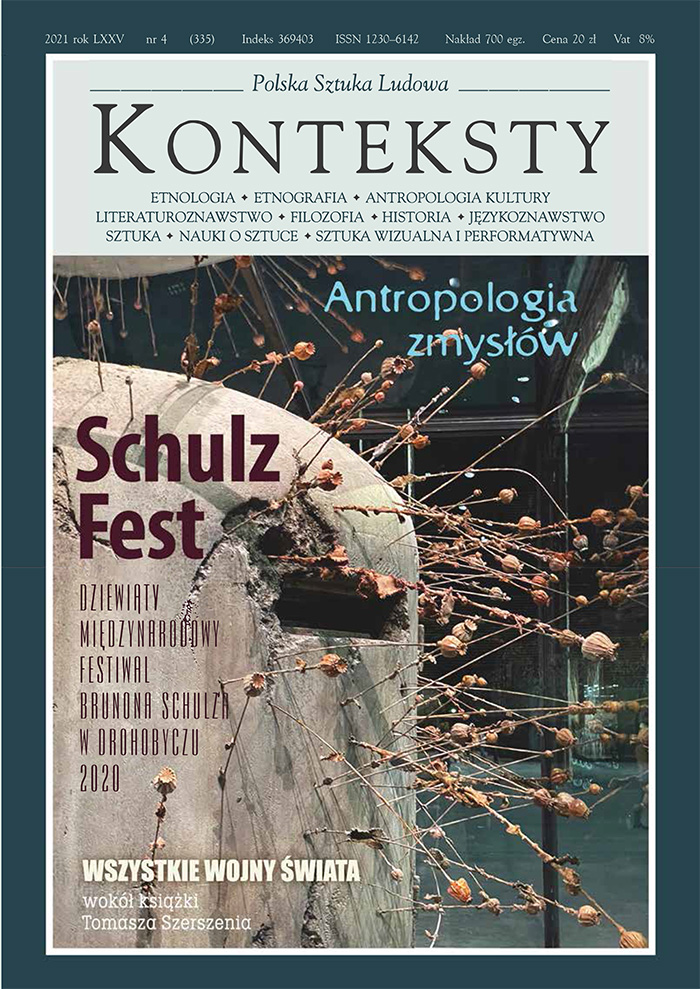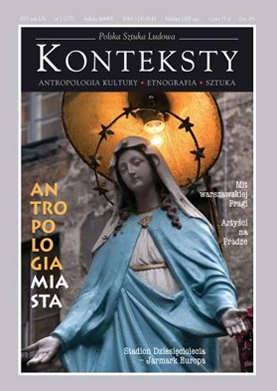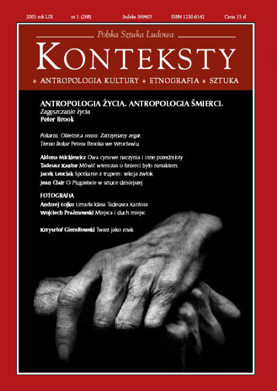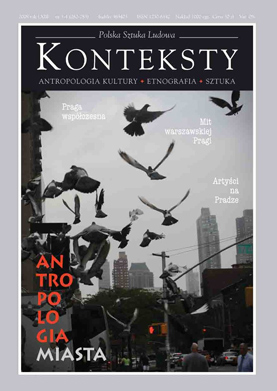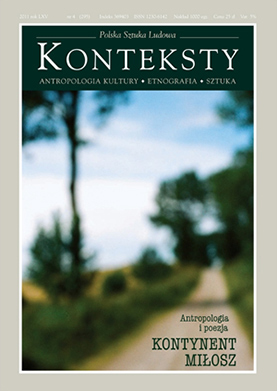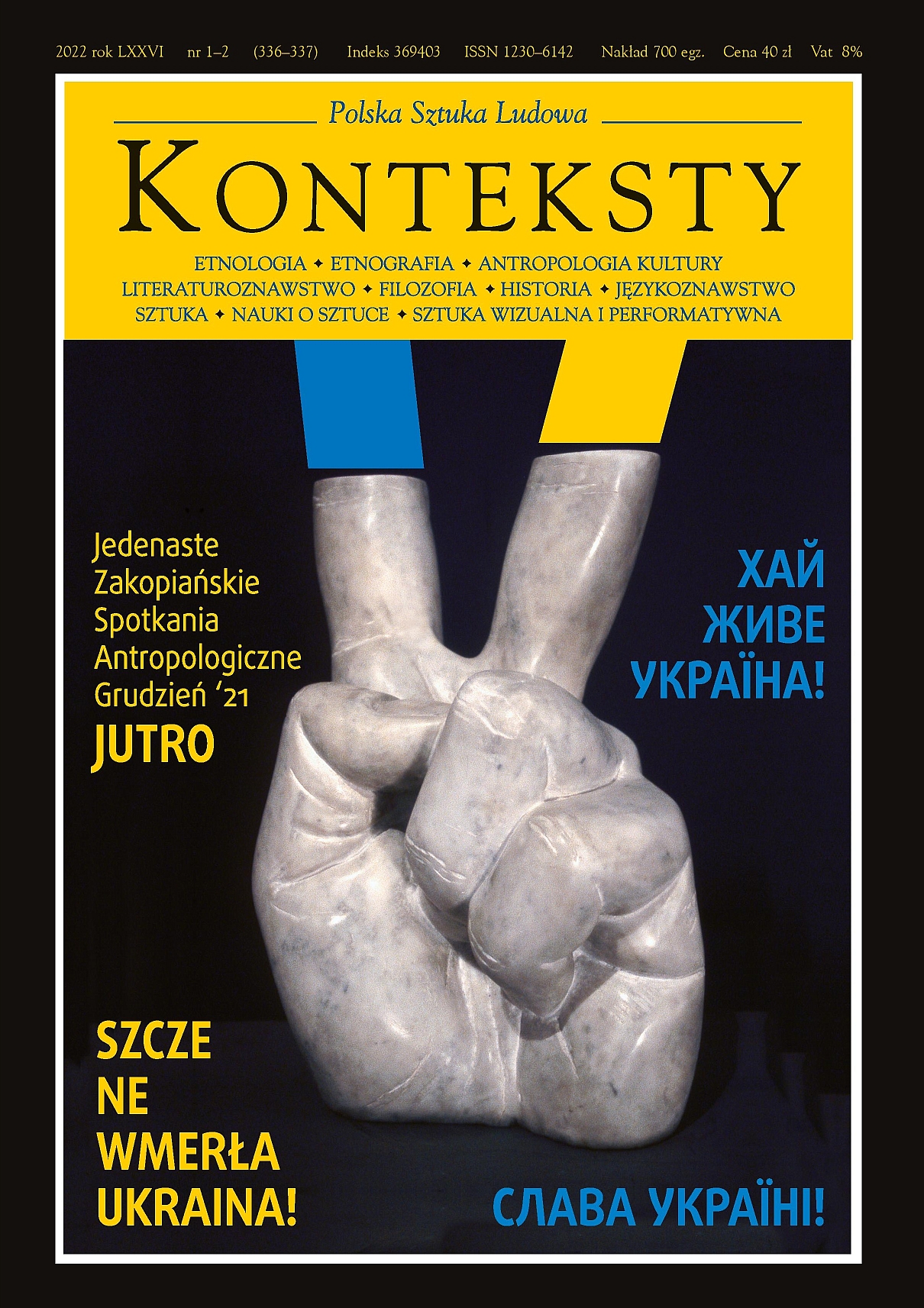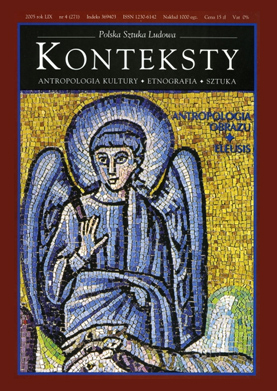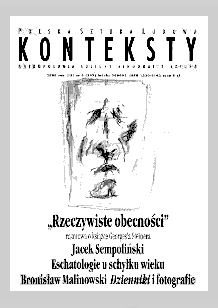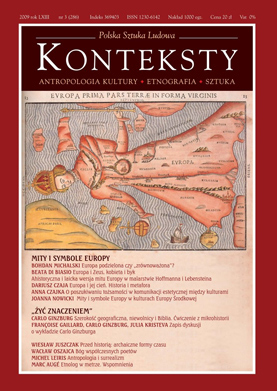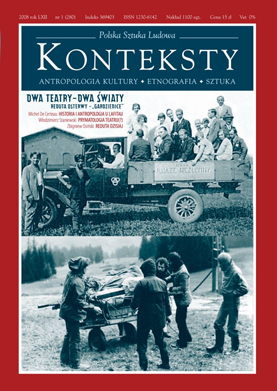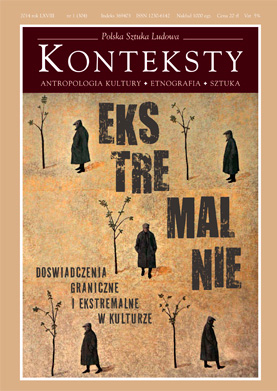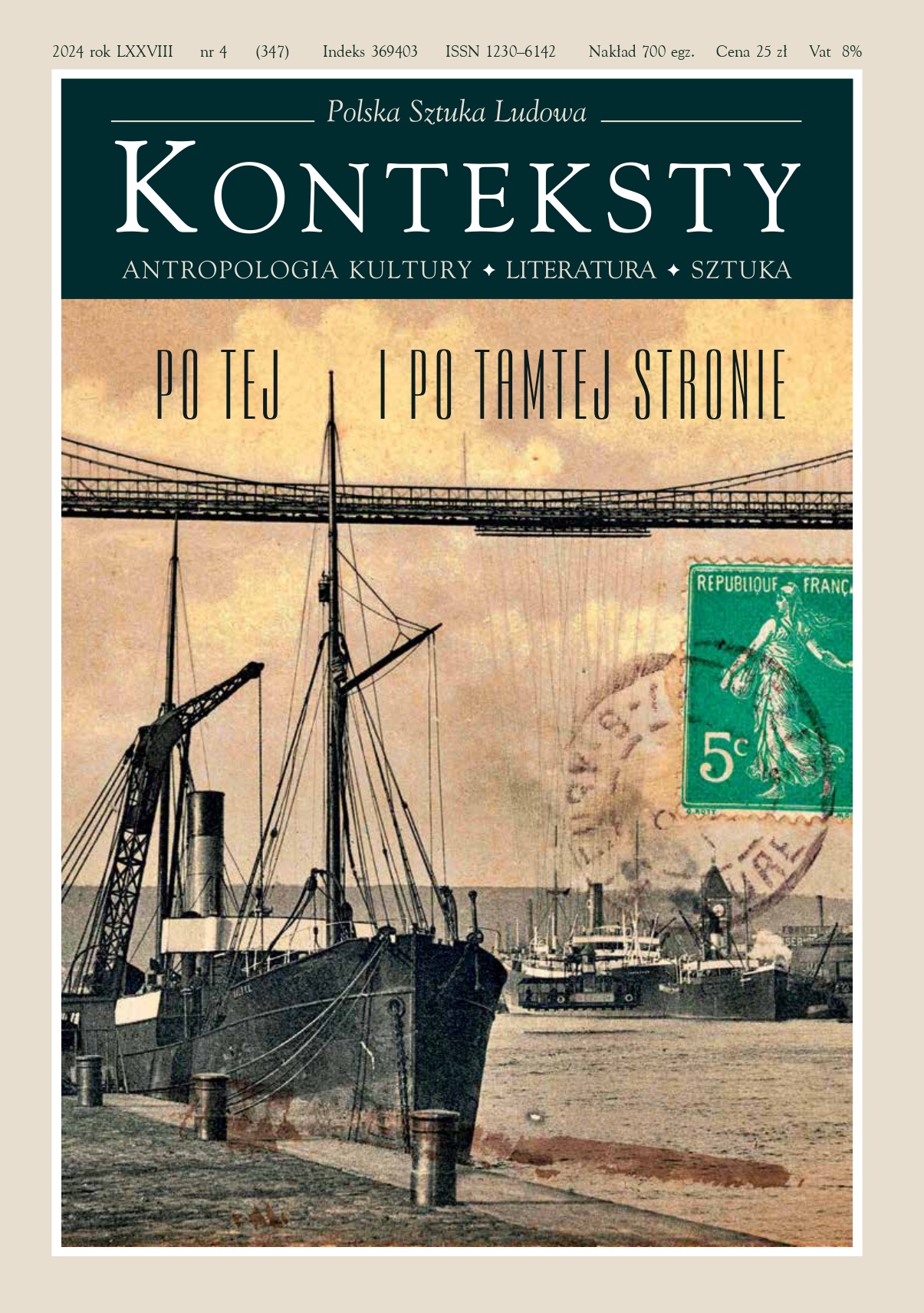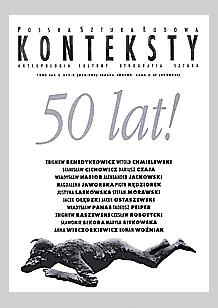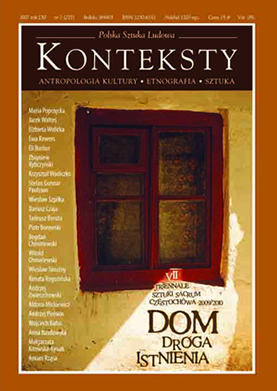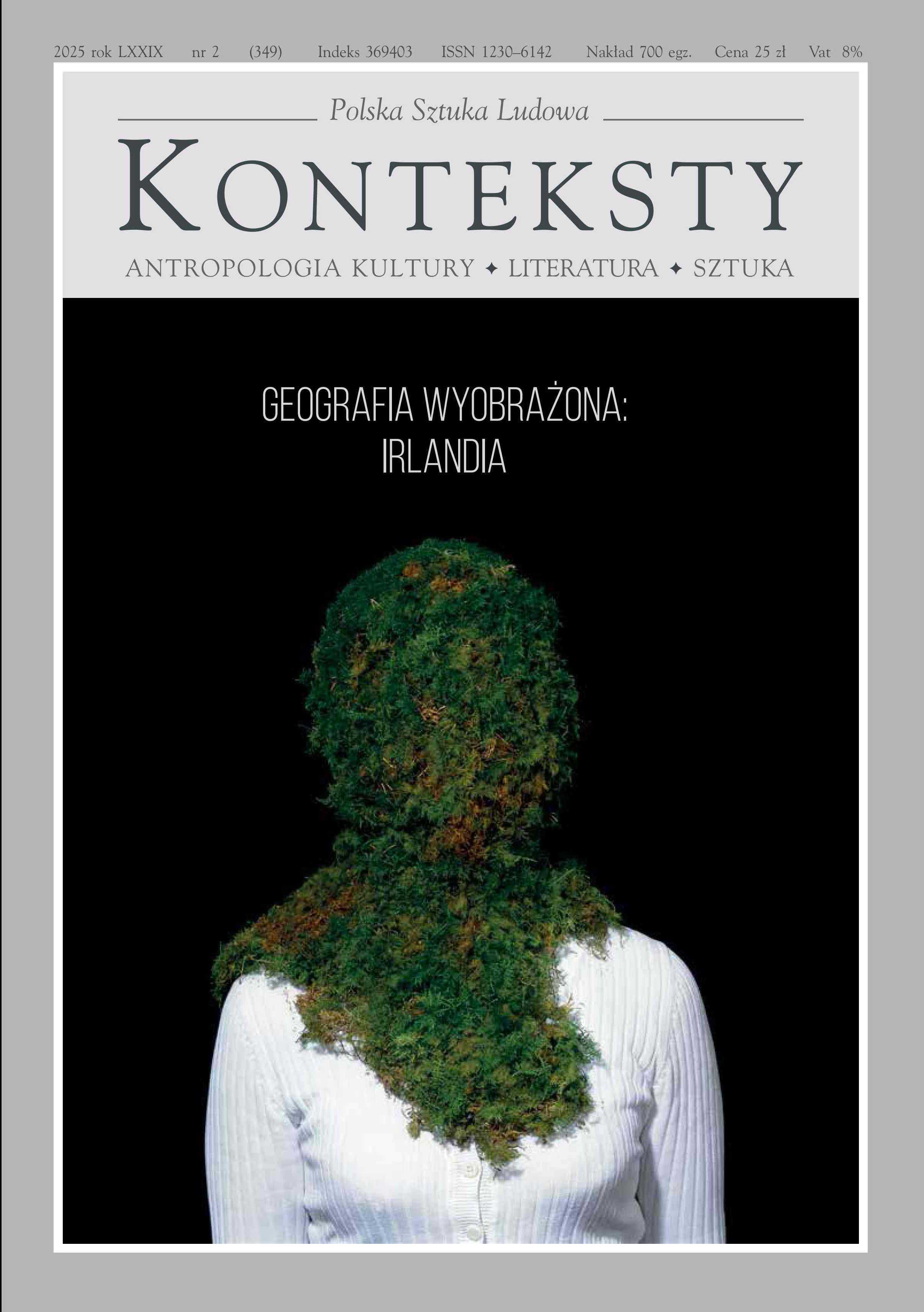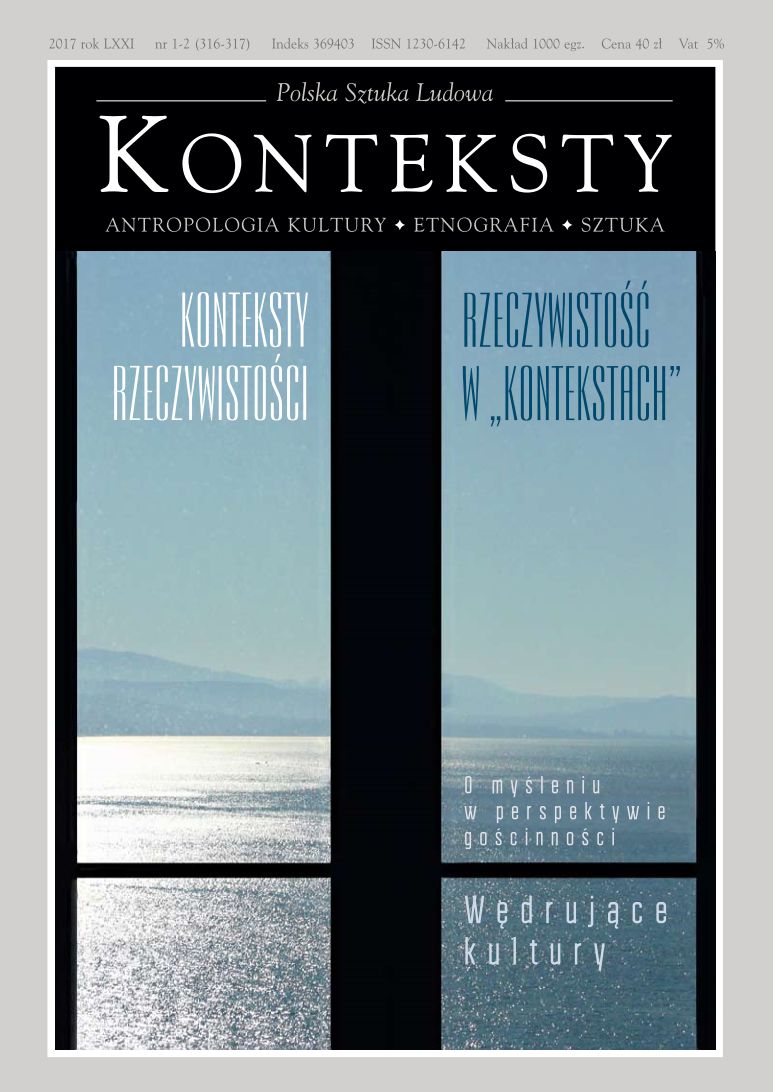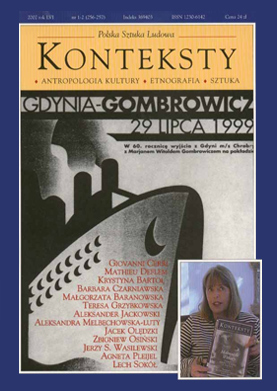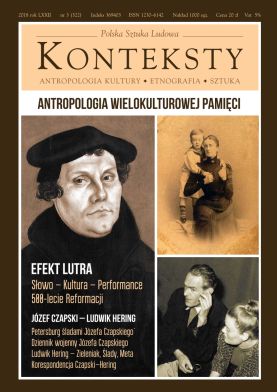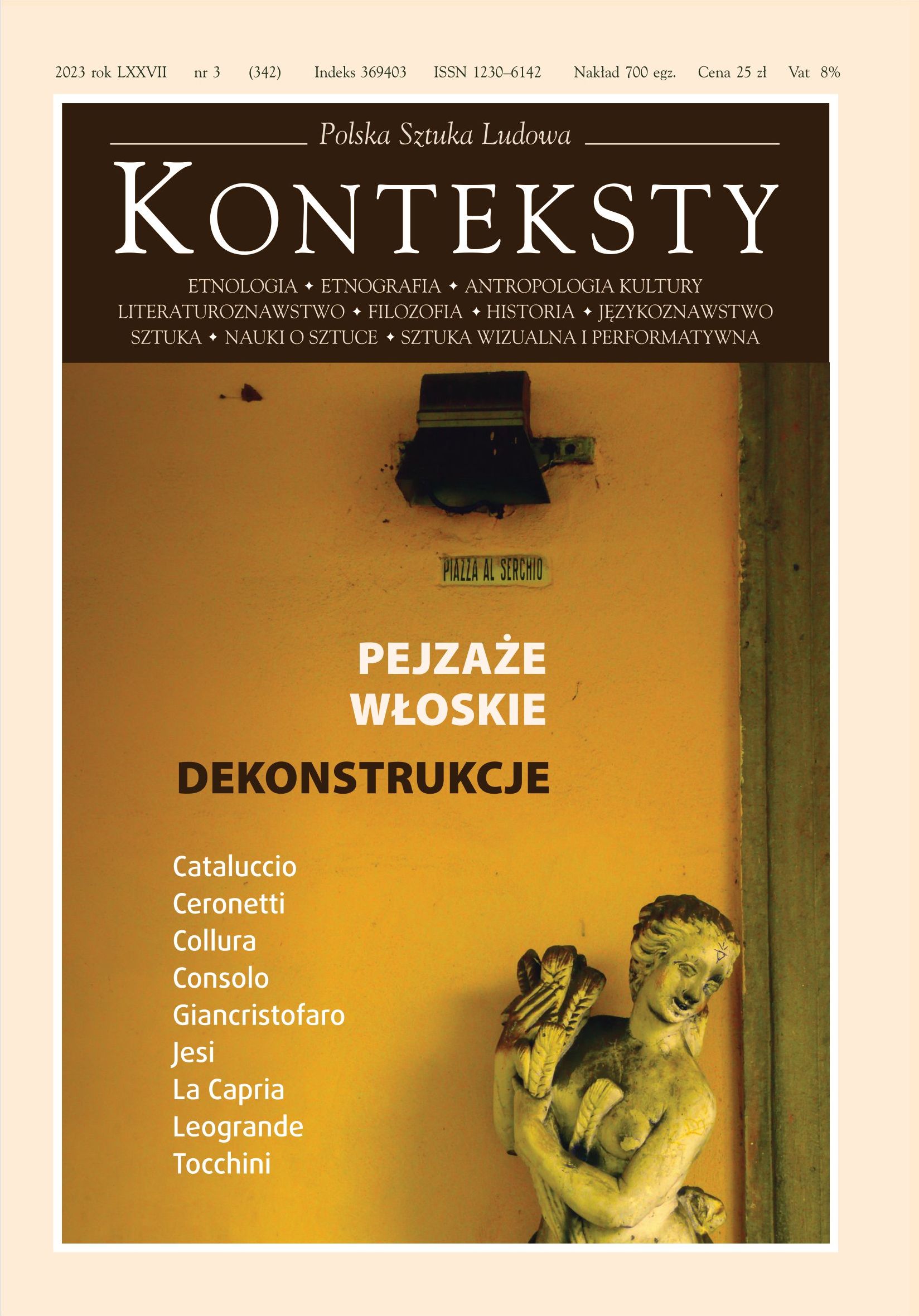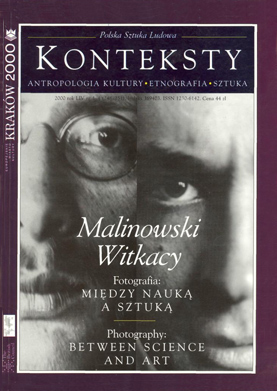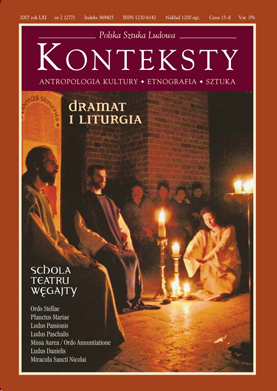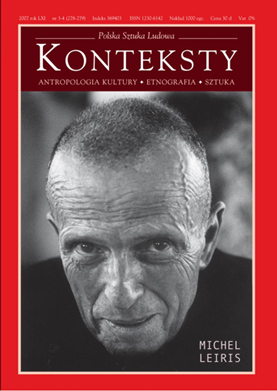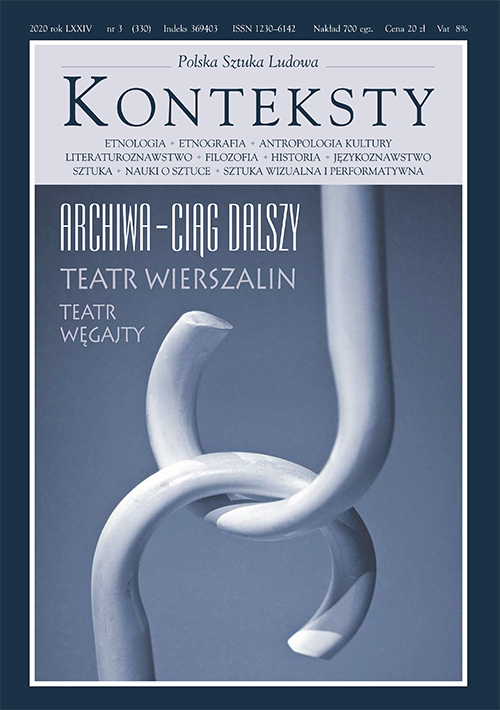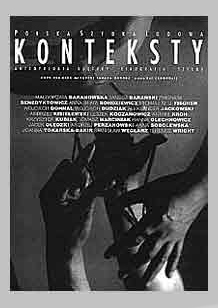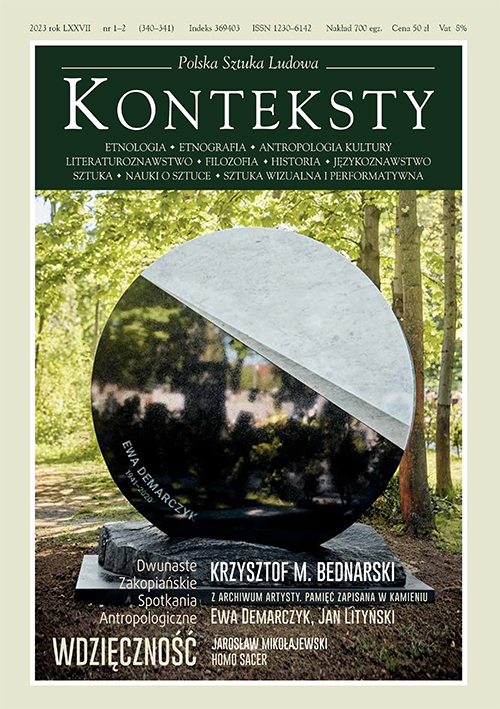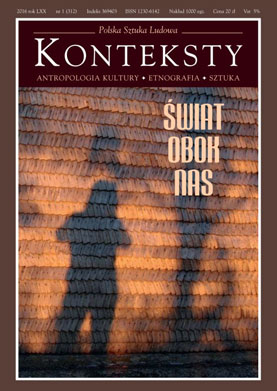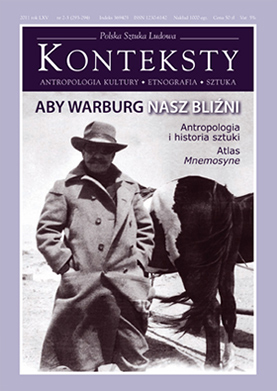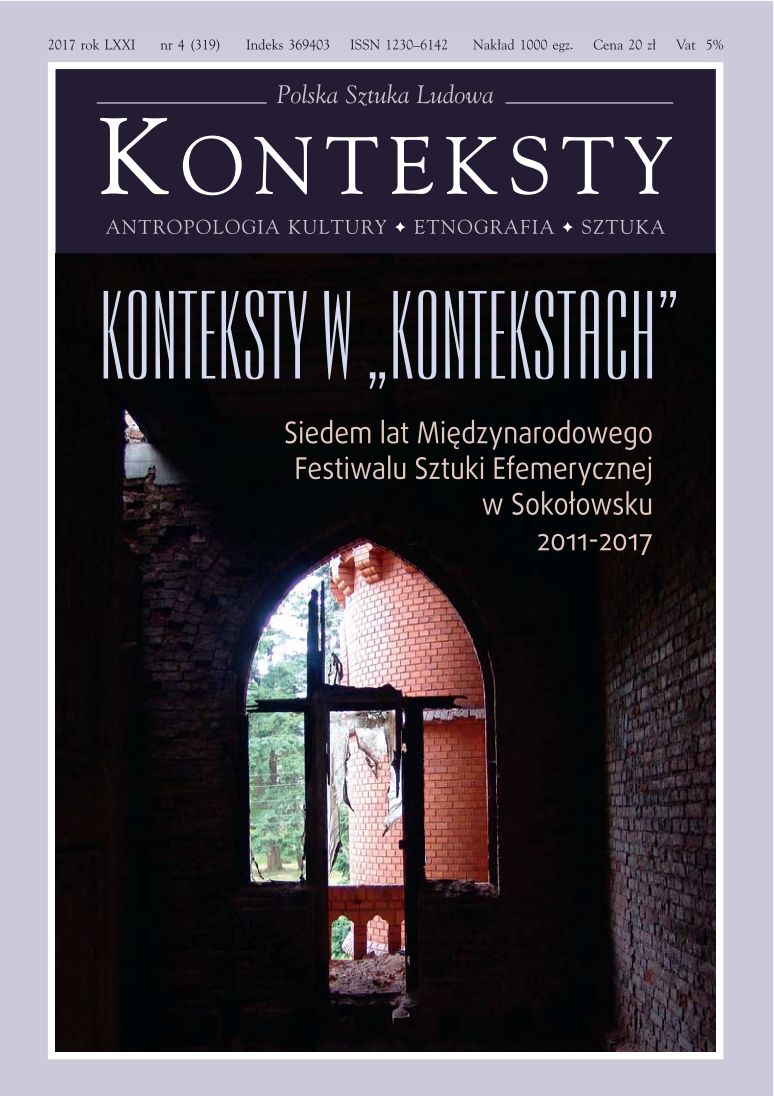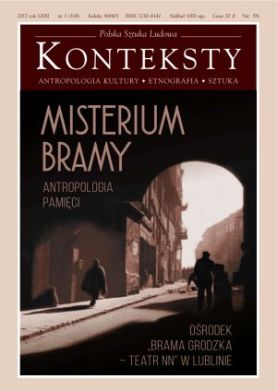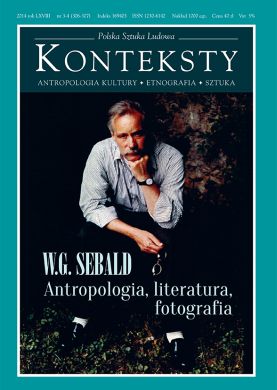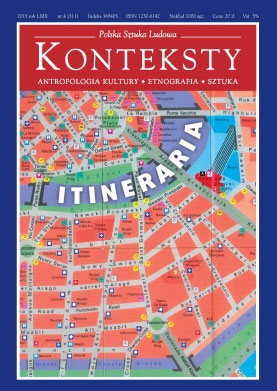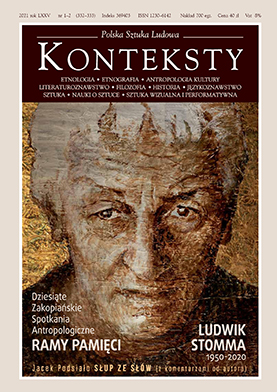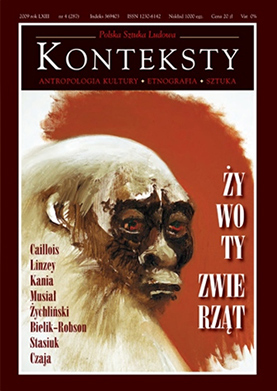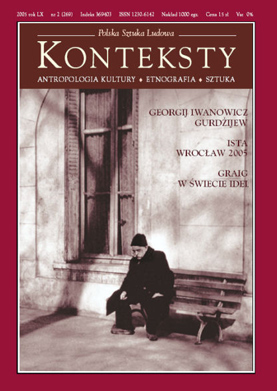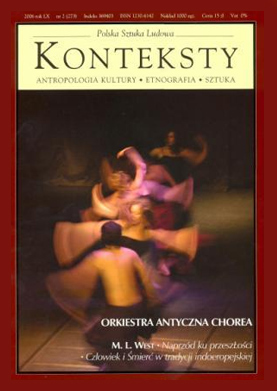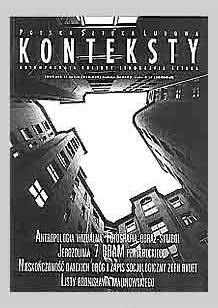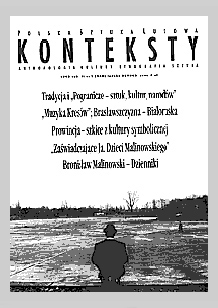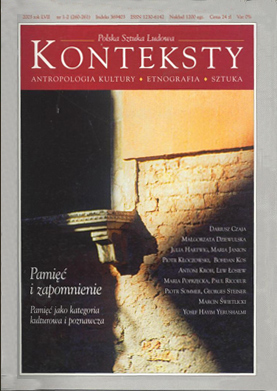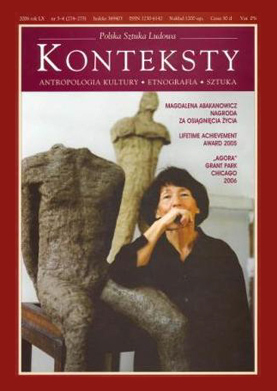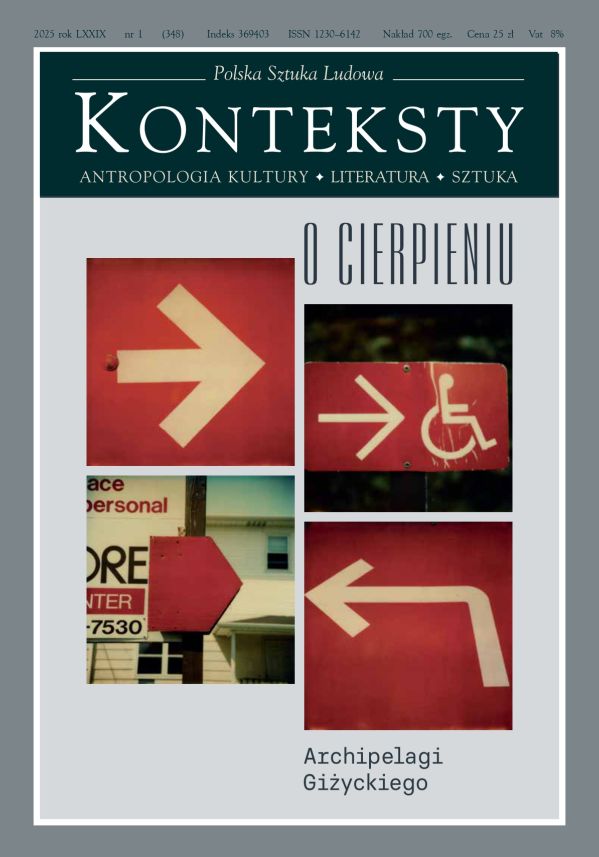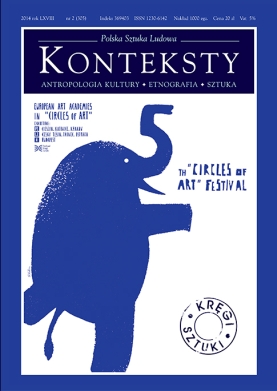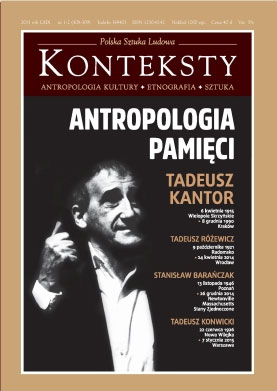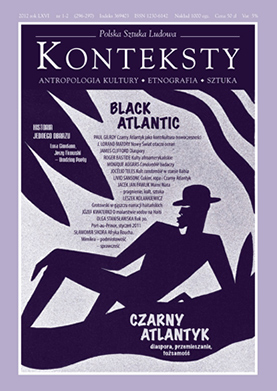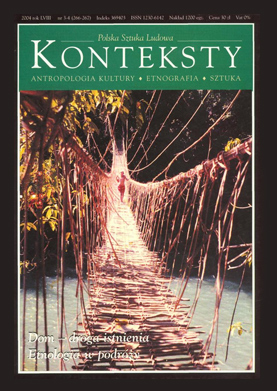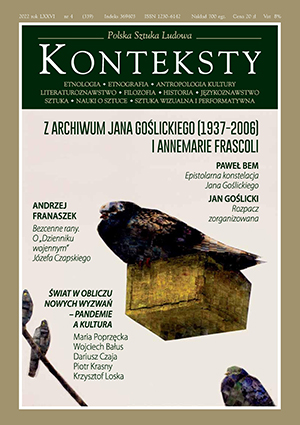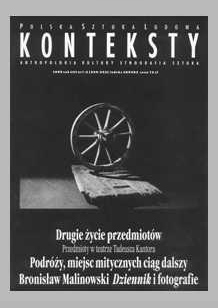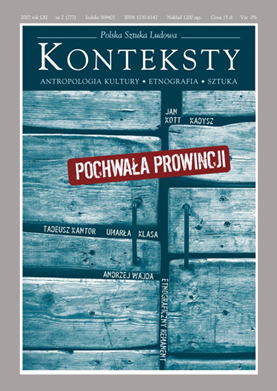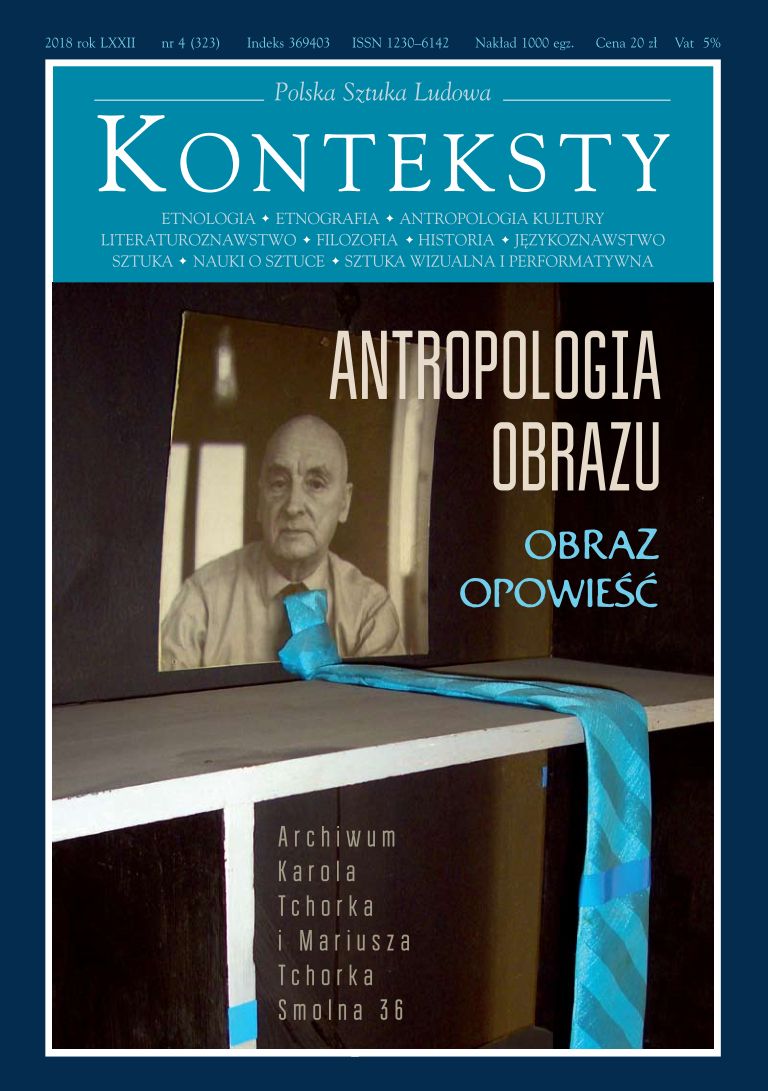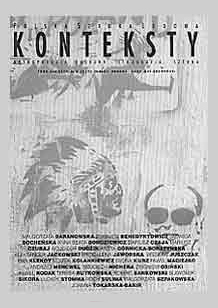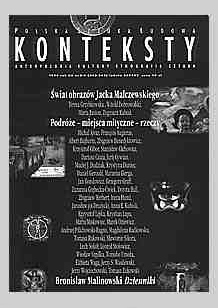Issue 2020/1-2 (328-329) -
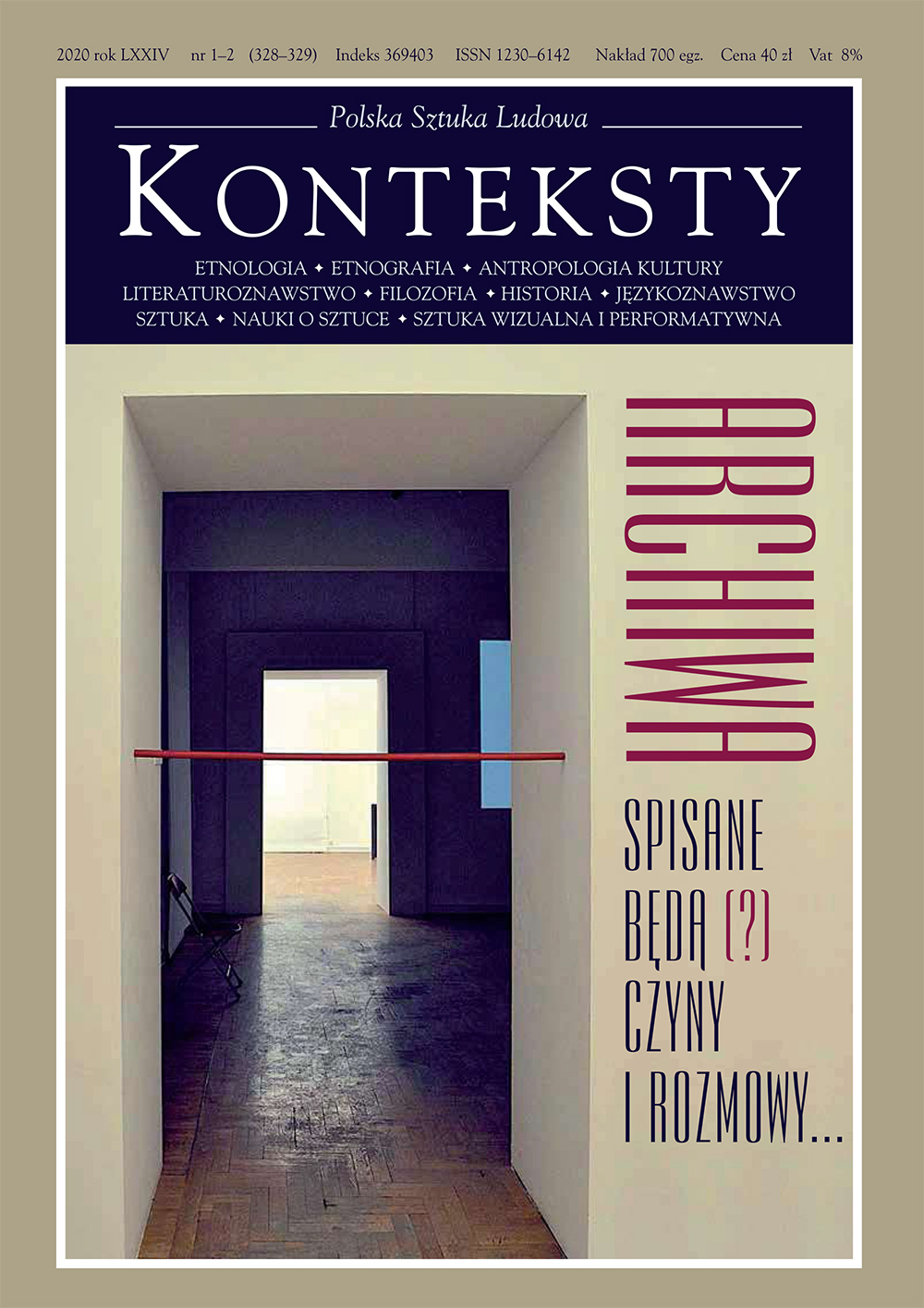
| * | Ludwik Stomma - Obituary | 4 |
| Ludwik Stomma | Moment | 10 |
| Ludwik Stomma | Daily Life as Normality | 14 |
| Archives. Deeds and Conversations Shall Be (?) Written Down. IX Anthropology Colloquium in Zakopane | ||
| Michał Klinger | Gradiva – Magdalene. The Problems of Archives  | 18 |
The problem posed within the Jensen–Freud–Derrida triangle in reference to Gradiva is confronted with a similar one presented in the Gospel regarding Mary Magdalene. Conclusions lead to the border between Archive and “life”, the problem of the relation of the Archive towards a unique event. The phenomenon of the Archive as interpreted by Derrida appears to differ from the hermeneutics of intertextuality. Along its borders it indicates a potential for recreating ancient hermeneutic methods – typological and verbal. Without tackling the challenges of preserving the “idiom” in the face of the force of semiosis and myth we would surrender to the “Grand Inquisitor”. | ||
| Tadeusz Bartoś | Deeds and Conversations Shall Not Be Written Down  | 31 |
The natural biological need for expansion and the confirmation of one’s existence either via offspring, accomplished deeds, or material and spiritual products are nourished by the illusion of indestructibility and the eternal memory of archives, which shall record all deeds and conversations. Meanwhile, nothing survives, omnis moriar. Certain philosophers (Nietzsche, Cioran) recognise the need for illusion and self-deception as an essential expression of life. Non-existence, therefore, and consequently nothingness comprise an encounter with the non-fictitious, a departure from the world of illusion. That, which actually exists, is nothingness. Evaluation (axiology of all sorts) is recognised as valuable and constitutes a bio-cultural motor stoking desires. The latter are a source of suffering. An attempt at thinking outside all axiology is Heidegger’s effort in a polemic with Nietzsche. There exists an urgent need for critical reflection on thoughtlessly linking existence and good. The Buddhist stifling of desires, consistently devised, denotes recognition of the absence of value. If nothing is valuable then, ultimately, nothing deserves to be desired. Only in this way may we consistently conceive that much vaunted nirvana. | ||
| Jacek Leociak | Buried Under the Ground: Texts of the Shoah Archive  | 36 |
The author treats the rescued documentation of the Ringelblum Archive as specific testimony. Nowhere in occupied Europe, and in no concentration of a Jewish population existing in the conditions of German terror was a documentation initiative undertaken on such a scale. Thanks to a group led by Emanuel Ringelblum, which called itself “Oneg Shabbat” (i.e. Joy of the Sabbath, from the day on which it usually met) there emerged an archival collection created according to strict methodological principles and realised as a research project by a team of professionals and representatives of science, literature, and culture as well as social activists. The phenomenon of the Ringelblum Archive, however, does not consist exclusively of its historical, cultural, and symbolic value. Testimonies collected while risking life were concealed in the ground. Their authors speak to us via their writing, because that too enjoys the rank of evidence testifying not only by means of that, which it transmits, but also the fact that it survived and exists, and the way it looks. The substance of the testimony, its texture, the paper on which it was written down, and handwriting are of absolutely key importance for the Ringelblum Archive. The discovered and unearthed texts successfully passed the test of four elements: fire – in the blazing ghetto and the fire of the Holocaust; earth – into which they were cast as seed sown for a future harvest; water – telluric dampness, underground streams dissolving and destroying the records, but also water submerging them in the whirlpools of oblivion; and, finally, air – discovery, liberation from darkness, extraction into daylight. | ||
| Paweł Próchniak | Aphonia. On the Reverses of Silence in the Theatre of Memory  | 47 |
A reverse is a side, the opposite, but (in Polish) also an IOU of sorts, evidence of a promise to pay back a debt. A word is the reverse of silence but also a reverse of that, which leaves a lump in the throat and renders us speechless. The word can be an obligation, including one that cannot be lived up to. The author attempts to reveal and vocalize thus comprehended reverses – well aware of the fact that actually he would like demonstrate the reverse of silence. The sketch discusses reflections dealing with the status, form, and semiotic potential of handwritten accounts of Shoah, for more than forty years part of the Jan Manugiewicz home archive and today in the possession of the “Brama Grodzka – Teatr NN” Centre in Lublin. An integral part of the article consists of reproductions of the accounts and their reverse sides. | ||
| Stanisław Krajewski | Identity Extricated From an Archive  | 54 |
An archive of sorts can exist within one’s body, cf. memory or DNA. Hidden archive containing the knowledge of one’s ancestors can sometimes induce a change of identity. Some Poles with Jewish roots have gone the way of de-assimilation, or the reversal of assimilation. Almost never does it lead to de-Polonization. At present, virtually all Polish Jews exist as Jews due to the process of de-assimilation. In the paper, a list of circumstances facilitating the process is presented. | ||
| Mieczysław Abramowicz | Gdańsk Archival Material in Jerusalem. The Bulwark of Memory  | 60 |
At the end of the 1930s Nazi terror aimed against the Jews of Gdańsk assumed such dimensions that a relatively normal existence of the Jewish community in the Free Town of Gdańsk (Danzig) became no longer possible. Following the example of the Third Reich the authorities introduced the draconian “Nuremberg laws”, forbade Jews to pursue free professions, illegally evicted them from their homes, fired them from work, confiscated property, and liquidated Jewish institutions. This was the onset of the great Exodus of the Jews of Gdańsk – out of 30 000 Jewish residents living in the Free Town in November 1938 not quite 1 500 persons remained in the city on 1 September 1939. The Exodus also affected the movable property of the local Jewish kahals, accumulated in the course of several centuries, as well as their archives. In the second half of 1938 the huge archive of the Gdańsk Synagogue Kahals (Synagogen-Gemeind) was taken to Palestine. Archival material from Gdańsk goes back to the end of the seventeenth century and consists of the documents of five Jewish kahals; the last ones originate from 1938. The Central Archives for the History of the Jewish People (CAHJP) were established in Jerusalem in 1939 – they gather archival material from Jewish kahals all over the world, the archives of Jewish institutions, and private archives of outstanding persons. Today, the Central Archives contain the most extensive collection of documents concerning the history of the Jewish people from the Middle Ages to modern time, including archival material from Gdańsk – memory about the residents of Gdańsk, who for several centuries together with other co-citizens built the might and greatness of the free Hanseatic town on the Motława, is thus preserved far from Gdańsk. | ||
| Tomasz Wiśniewski | Miscellanies in the Theater. A Few Words of Introduction to the Subject of Archives  | 66 |
This short essays presents some thoughts on the status of archives in Polish theatre studies. Historical perspective is taken into consideration, when discussing various approaches to the dichotomy of memory and oblivion. Particular attention is given to performative aspects of theatre archives. In this context, some conclusions are drawn from assumptions expressed by Professor Jan Ciechowicz and concerning objectives of theatrical research. | ||
| Katarzyna Kręglewska | Memory of Practices – Practices of Memory. Archives of the “Gardzienice” European Centre for Theatre Practices  | 69 |
This article focuses on the theatrical archive of the “Gardzienice” European Centre for Theatre Practices, with the author discussing both the material dimension and type of documents gathered in this space so as to next analyse ways of using archival material in the daily practices of “Gardzienice” and formulate a thesis about the mutual conditioning of contemporary theatrical and archival practices. | ||
| Małgorzata Sady | In the Themerson Archive in London and What Happened Later  | 79 |
This text is an account of the history of the Themerson Archive based on the personal experience of its author. The life and versatile oeuvre of Franciszka and Stefan (avant-garde film, photography, publishing, painting, drawing, graphic design, stage design, philosophy, literature, theatre, opera, typography) left behind material traces of great significance and substantial size. Jasia Reichardt, the Themersons’ sole heir and renowned art critic, together with her husband the art historian Nick Wadley, devoted 25 years to organising the legacy. The archive’s first location was Jasia’s home in London. Małgorzata Sady was a friend of the Themersons for the last ten years of their life, and thus she received and accepted the proposal to work there. Since the 1990s she has also been involved in promoting Themersons’ works in Poland and abroad. In 2013 the Themerson Archive was acquired by the National Library in Warsaw. It has been digitalized and gradually made available on the Polona website. | ||
| Paweł Drabarczyk | Fever and Ashes. Robert Kuśmirowski’s Museum of Deposited Art  | 85 |
According to Paul Ricoeur all sorts of traces are suitable for archivisation; among them he mentioned also urns. In Robert Kuśmirowski’s “Museum of Deposited Art”, sometimes known as the “art columbarium”, urns are used for storing works of art – unrequired, unsuccessful, unexamined, forgotten, small losers in the world of art – cremated in the presence of a committee. “I only wish to take care of them – declares the artist – to extract them from non-existence and to somehow preserve them in memory. With suitable theoretical and conceptual care they lose nothing and merely change their parameters”. The Museum preserves the remnants, writes a destruction protocol, and keeps records. The Kuśmirowski project – a sui generis museum of the imagination defeated in a confrontation with the scale of present-day artistic production – is an extreme institution, in which it would seem that the frenzy of cataloguing and compulsory commemoration had ultimately ousted the seemingly fundamental purpose: in order to save from oblivion one has to destroy. Contrary to other fears expressed by Jean Clair and addressed to museums in which instead of presence we find emptiness, the latter appears to be some sort of a solution. After all, to deposit also means to place in a grave, but not without hope. Kuśmirowski appears to refer to the great pariahs of art by citing Pierre Nora: “Archive as much as you like: something will always be left!”. | ||
| Tomasz Szerszeń | Archive: Between Life and Death. A Look at Marek Piasecki  | 92 |
An archive is always situated on the borderline of life and death, culture and nature, memory and oblivion, order and chaos. Its essence, therefore, contains an inherent contradiction. It could become a refuge but also a prison, and a boundless force engrossing its creator but also everyone who examines it. Finally, it could be the space of contradictory declarations and secrets, which remain unutterable. The archive leads us to other archives, other stories, worlds, and micro-galaxies. This is true in the case of Marek Piasecki (1935–2011) – photographer, creator of heliography, objects, and collages, reporter of “Tygodnik Powszechy”, member of The Second Kraków Group, engaged in the activity of the Miron Białoszewski theatre. From 1967 Marek Piasecki was an émigré in Sweden, where he remained to the end of his life. His oeuvre – slowly being recalled – still conceals multiple secrets. The prime motif of the presented text an attempt at taking a close look at this unusual person (and his works) via his scattered archive and the fate of successive ateliers-artist’s habitats. | ||
| Leszek Koczanowicz | Postcard and Memory Archive  | 109 |
Obviously, people are incapable of functioning without memory, but it is just as easy to see that memory is the source of trauma and anxiety. New, extremely difficult tasks for memory emerged in the modern age. We must remember a divided and scattered world that cannot be put in order according to some sort of coherent patterns. At the same time, we must learn how to forget or at least to control ”bad memory”, which is a source of trauma. The author of the presented essay raises all those questions while discussing a postcard he received from his Mother shortly before her death. While referring to Derrida’s book about the postcard and other philosophical and literary texts, and in particular Plato’s conception of recollection, as well as neurological memory mechanisms, he attempts to understand the message contained in this ostensibly banal communication. | ||
| Dariusz Czaja | Memory and Glass. Archive of Dead Faces  | 113 |
The topic of this text is the photographic archive of Stefania Gurdowa. An unexpected discovery of her 1200 glass negatives, walled up in an attic in one of the town houses in Dębica, was made in 1997. Intermittent numbering demonstrates that we are dealing with fragments of a wider photographic body (whose extent remains unknown). The very existence of this collection (which is actually coincidental) generates two important questions: what does the process of situating photographs within an archival context say about them, but also what do they contribute to knowledge about the composite and unambiguous idea of an archive? While attempting to bring the Gurdowa archive alive the author of the article confronts the artist’s glass images (in a representative selection) with poems-biograms from Spoon River Anthology by E.L. Masters. | ||
| Katarzyna Prot-Klinger | Reading the Body Archive  | 131 |
The article refers to the concept of the body as an archive of own and previous generations’ experiences. This applies in particular to trauma, unconsciously determining our behaviour, and undergoing embodied enactment. In a specific therapeutic situation there may take place a reconstruction of body sensations, affect, and fantasies associated with the traumatic situation. Basin herself on the Torok and Abraham theory of the crypt and the phantom, the author shows how the body becomes a narrative area. She describes Dori Laub’s project of recording accounts of Holocaust survivors hospitalized in psychiatric institutions as an example of “archive fever”. Archiving trauma is a special case of archive fever because traumatic experience that cannot be archived in the mind is sought in the recording. It is an archive search outside the archive, despite the inability to archive. | ||
| Dorota Koczanowicz | Memory of the Palate. Taste and the Archiving of Identity in Installations by Anna Królikiewicz  | 138 |
The axis of this article consists of installations by Anna Królikiewicz, who changes simple everyday rituals connected with the preparation and sharing of meals into art rituals. The artist “locates memory in the stomach” and her artworks constitute a laboratory examining relations between memory and eating. The Królikiewicz method involves a synaesthetic transmission of impressions from one domain of arousal to another. By means of flavours and aromas the artist tries to restore the memory of past situations, places, and persons. In the Królikiewicz oeuvre once living existence assumes the form of sensual traces leading the viewers to Sopot and Gdańsk of the past. | ||
| Monika Sznajderman | Night-time Revocation of Names. Report from the First Step. Reflections Against the Backdrop of Several Readings  | 145 |
The outstanding mathematician Hugo Steinhaus spent the Second World War hiding in the little foothill town of Stróże. After the war he published Wspomnienia i zapiski, a book recalling this small occupation-era fragment of the world. M. Sznajderman wonders whether it is possible to construe a true story about history based on its fragment, a shred, an incomplete account determining the time and place in which the author of the account lived. Is such a story legitimate archival material or merely an archive footnote? And does the archive contain a ready, complete narrative, a total story waiting for us, or does it ultimately leave us with an experience of lack, loss, and melancholy? | ||
| Lech Sokół | Berlin Monument | 155 |
| Monika Krajewska | Crumbs. Cutouts from the “Burning” Series | 157 |
| Janusz Bohdziewicz | Ferment – an Open Archive of Christianity. A Negative Archaeology Sketch | 161 |
| Wojciech Michera | “I rest my head for a moment on the letter box”. On Postage Stamps and Postcards the Example of France  | 169 |
The mid-nineteenth century witnessed the simultaneous emergence of two new types of iconic media: the photograph and the postage stamp. For the next 150 years the two moulded visual culture by defining its important practices. The photograph became the central theme of widely comprehended studies on the image and visual culture, but “postcard pictures” became enclosed in the intellectual ghetto of philately, on an extremely distant margin of interests pursued by culture studies. The topic of the article deals, therefore, with postal practices from the turn of the nineteenth century, discussed upon the example of France: the cultural consequences of phenomena treated, as a rule, solely as postal technology. This is an opening fragment of a book about the anthropology of the postage stamp. | ||
| Magdalena Barbaruk | Epos of the Chilean Awakening  | 186 |
The author of the article interprets events that started in Chile on 18 October 2019 and are known as that country’s “awakening” or “Chilean spring”. They consisted of mass-scale demonstrations calling for, i.a. a new constitution, free-of-charge education and health service, and respect for the rights of women and the indigenous population. Attention is drawn to the fact that the semantics of the actual upsurge is intensified by parallels with the coup d’état of 11 September 1973 and the plight of thousands of desaparecidos. M. Barbaruk is of the opinion that the large-scale social mobilisation, the first to take place after 30 years, and its new martyrs (several score persons perished, hundreds lost their eyesight) calls for an epic poem that would describe the desired trajectory of transformations. In doing so she referred to Andrzej Leder’s remarks on “the unwritten epos” about Polish peasants. In the case of Chile the difficulty of writing an epos consists of linking the revolt with new media: video mapping (the dialogue of the Delight Lab artistic collective and President Sebastián Piñera), the Internet (amateur recordings of acts of violence, the use of YouTube) and short-lived “archives”, i.e. murals, which altered the appearance of the capital city, songs performed to the accompaniment of cacerolazo or new names given to assorted sites (Dignidad Square). In her interpretation the author resorts to conceptions launched by W.J.T. Mitchell (an analysis of the Occupy phenomenon) and R. Calasso, but its foundation consists of personal experiences from Chile. | ||
| Piotr Jakub Fereński | “Vulture”  | 195 |
The intention of the author of this article is not solely to present the possibilities of becoming more thoroughly acquainted with events from the past thanks to an analysis of family memory deposits (composed of verbal sources and documents in private collections), but also an attempt at “taming” certain facts. Piotr J. Fereński deliberates on the history of his grandfather, who during the 1930s worked in enforcement authorities but also took part in repressing the political opposition, at the time of the German occupation was simultaneously a member of the Blue Police force and a member of the Resistance, and after the Second World War worked in the Special Commission for Combating Misappropriation and Economic Abuse and then spent four years as an inmate of the prison in Rakowiecka Street in Warsaw. Through the prism of Falcon’s history his grandson demonstrates how difficult it can be to understand and assess stands, decisions, and behaviour of people forcefully flung by twentieth-century events and historical processes. | ||
| Krystian Darmach | Archivisation of the Archive. The Creation of a New Context of Archivisation upon the Example of the Digital Photograph Repository – “Workers in the Nineteenth and Twentieth Century”  | 206 |
The text is about the unusual history of the creation of the archive and the characteristics of digitized materials from the Institute of Ethnology and Cultural Anthropology of the University of Łódź creating a digital photo repository. The story of the creation of the collection and the forms of its sharing will be a reflection on the emergence of new contexts for the reception and interpretation of collected artifacts. From the family archive, through the Archives of Institutions (IEiAK UŁ) to the digital repository available on the Internet. At each of these levels, there is a transformation of content and ranges of impact and access to materials. I would like to look at these re-figurations, transformations, ways of using resources, read the changing formula of archiving, among others in the perspective of the Bruno Latour network theory-actor, treat the archive, repository as a laboratory of sources and research activities and servers, for example, as heterotopy. | ||
| Marta Zimniak-Hałajko | Social Movements’ Archives. On Social Value of Counter-knowledge  | 210 |
The article is an attempt of applying a notion of archive to the analysis of processes of accumulation and distribution of knowledge considered by social movements as valuable. The author traces interdependences between knowledge accumulated in social archives (and ways of its organisation) and productivity and performative power of those archives. She takes a critical look at the idea of collaboration between researcher and researched groups in process of knowledge production, as used in engaged anthropology methodology. | ||
| Jan Szpilka | Rubbish Dump of Anger. The Temporality of the Experiences of the Transgender Punk Movement  | 216 |
An attempt at reflections on connections between a vision of the punk current as youthful rebellion, which one simply grows out of, and theories analysing the alternative “time of life” of queer persons. By referring to examples of contemporary punk music created by transgender female artists the author endeavours to indicate how such creativity contests chrononormative models of growing up and life. | ||
| Maciej Krupa | Genizah. On Cemeteries of Memory  | 223 |
Starting from the institution of genizah – in the Jewish tradition a specific cemetery of unused, destroyed books – the author describes and analyses various forms of dead, unused libraries, archives, museum collections, and their literary performances as well as various forms of non-reading. | ||
| Kuba Szpilka | Apparent Presence  | 230 |
Apparent Presence is yet another attempt at interpreting the cultural event that is Zakopane. While resorting to Magdalena Hoły-Łuczaj’s Radykalny nonantropocentryzm. Martin Heidegger i ekologia głęboka the author of the article seeks the possibility of representing and devising weak and marginal spaces, ousted in Zakopane existence. Additionally, he asks about the significance and sense of a presence that tries to make an appearance. | ||
| Ryszard Ciarka | In Search of Traces, or on the Bierwce Archive in Kruszyna  | 235 |
In a brief landscape interpretation, not devoid, however, of more profound reflections, the author attempts to capture the meaning of his 40 years long stay in the village of Bierwce (Mazowieckie voivodeship, county of Radom). In addition, he presents an account of the activity pursued there and, predominantly, the unconventional archive being created in Bierwce. | ||
| Barbara Major | Sketch on Sketches, Sketchbooks, and Sketching  | 243 |
An outline of a project of studies on the sketch and the sketchbook. The author considers the polysemic nature of both terms and is particularly interested in the specific temporality of the sketch and situating it in the gap between the past and the future. In addition, she poses questions about the status of the sketch in relation to the completed work. Emphasis is placed on the significance of the sketch as a “handmade” object. | ||
| Maria Prussak | Lost Book Collections  | 250 |
The article is about the value of archives and book collections belonging to scholars and conceived as sources for the history of the reception of new methodologies, the establishment of contexts, obtaining publications difficult to access, and the creation of milieus cooperating beyond all state frontiers and political systems. A distinct problem involves dedications inscribed in books as well as notes on margins and underlining. Studying book collections makes it feasible to follow the course of scientific discussions not recorded in official appearances and publications. | ||
| Anna Jędrzejczyk | Mathematics and Caricature. Passions of Leon Jeśmanowicz  | 258 |
Manuscript titled Mathematics and caricature. Passions of Leon Jeśmanowicz describes an interesting figure of great scholar and caricaturist. The manuscript was inspired by collection of theatrical caricatures authored by Jeśmanowicz, which is located in the theatre documentation of The Institute of Art of the Polish Academy of Sciences (IA PAN). Collection presents artists of Vilnus theatres, operating under the leadership of Leopold Pobóg-Kielanowski during World War II. Pictures of artists, which are iconographic recordings of performances from those times, were also printed by IA PAN in publication about theatre in Vilnus. The author of portraits, mathematician by profession, but also a theatre enthusiast, had lived in Vilnius until the end of the war, then, since 1946 he has settled permanently in Toruń. He became a great mathematics teacher with professor’s title. His second passion, which he shared with mathematics from youth, was caricature. He was drawing constantly, not only people of theatre, but also family and friends, fellow mathematicians, associates, officials and randomly met figures. Many documents, which comprise whole life of Jeśmanowicz and are kept in the Archives of Nicolaus Copernicus University, show that Vilnius portraits are only a small part of the Jeśmanowicz creation. Those documents show a huge number of his theatre and other caricatures from 1930s, World War II and period after war. Other archival reminders and publication titled Leon Jeśmanowicz (1914-1989) we wspomnieniach współpracowników i przyjaciół [Leon Jeśmanowicz (1914-1989) in memories of associates and friends] complete the image of scholar-artist, who was called Renaissance Man in a community. | ||
| Marta Leśniakowska | Concurrent Non-concurrence in a Photographic Veduta  | 268 |
Analysis of a cycle of photographs taken by two artists: Agata Pankiewicz and Marcin Przybyłko, dedicated to the contemporary architectural / cultural landscape of small towns in Lower Silesia. The photographs refer to several problems of key importance for contemporary artistic practices: the current of new documentalists, the anthropological turnabout, and anthropological/ethnographic photography (the photographer-artist as an anthropologist), as well as the anthropologically oriented turn towards the object. The theme of the cycle is architecture and the photograph. The project is based on the idea of new documentalism, namely, that the presentation of a landscape should create rather than simply register (G. Defferre), and that “Art does not reproduce the visible; rather it makes visible” (Paul Klee). The Lower Silesian cycle presents a culture clash whose participants and victims include architecture, as well as the effects of complex socio-cultural processes – the outcome of the post-war contact of different cultures in terrains known after World War II as the Regained Territories. The present-day architectural landscape of the Regained Territories is particularly clearly visible as an image mediated in the photographic image since the characteristic feature of the photograph, and the photograph alone, is temporality containing the past, its dissolution, and the future. Due to this feature, the Lower Silesian cycle sets into motion figurativeness described as “the archaeology of the contemporary past” (Michael Shanks). | ||
| Piotr Sypczuk | Adam Wisłocki during the Wilno Period of His Activity 1923–1927: a Contribution to the Biography of the Photographer and Filmmaker in the Light of Unknown Archival Material  | 277 |
Adam Wisłocki is a recognised filmmaker and photographer, who perfected his workshop under none else but Jan Bułhak, professor at the Stefan Batory University in Wilno. Nonetheless, pertinent writings about this colourful figure remain modest, and the Wilno stage of his activity still calls for detailed studies. Today, it is possible to ascertain in the light of up to now unknown archival material that from 16 June 1923 to 30 April 1924 Wisłocki worked at the Art Department in the Office of the Government Delegate in Wilno. His chief duties included taking photographs of historical monuments in the Wilno and Nowogródek voivodeship. The resultant photographs comprised the core of the Art Department in Wilno; today they are kept at the Institute of Art of the Polish Academy of Sciences. Subsequently, Wisłocki was a secondary school teacher. From 1 November 1924 to 32 August 1926 he taught geography at the Józef Piłsudski State Gymnasium in Święciany (Wilno voivodeship), and from 1 September 1926 to 1 January 1928 he was a teacher of geography, contemporary Polish studies, and history at the Tadeusz Czacki Co-educational Gymnasium in Wilno. At the time, his great accomplishment as a filmmaker was the commemoration of the coronation of the miraculous icon of Our Lady of Ostra Brama, which took place in 1927. The film won the recognition of the state authorities, film critics, and audience, and the press hailed Wisłocki as its chief author. In the wake of this success Wisłocki left for Warsaw, where he found employment in the Central Film Office. | ||
| Krzysztof M. Bednarski | Red Crossbar | 283 |
| Krzysztof M. Bednarski | Resistance – Grzegorz, Staszek, Rafał | 286 |
| Krzysztof M. Bednarski | I’ll be Right Back, Mum | 289 |
| Krzysztof M. Bednarski | Blow-Up | 292 |
| Archive Boundaries | ||
| Agnieszka Karpowicz | Archive Boundaries. Introduction | 297 |
| Magdalena Zych | This Theme  | 298 |
This Theme is a portrayal of the presence of the theme of Holocaust in the post-war circulation of folk art in Poland: the oeuvre of artists and the strategies of collectors, custodians, and curators. The author devotes much attention to the role played by Aleksander Jackowski, for many years editor-in-chief of “Polska Sztuka Ludowa” (1952–1998), in generating the reception of so-called “naive art”. References to biographies of persons creating the circulation of this particular art together with their wartime experiences comprise a backdrop for reflections dealing with the impact of anti-Semitism in Polish culture. The text was written upon the basis of the outcome of the Awkward Objects of Genocide research project realised as part of the activity of the Transmitting Contentious Cultural Heritages with the Arts: From Intervention to Co-Production: TRACES (2016–2019) European consortium concentrated on controversial European heritage. More on: www.widokzzabliska.eu (www.terriblyclose.eu). | ||
| Małgorzata Zawadzka | Photographic Memory. Photographs from the Jarosław Iwaszkiewicz Family Album in the Archive of the Museum in Stawisko  | 310 |
Collections of the Anna and Jarosław Iwaszkiewicz Museum in Stawisko, established in the house in which the writer and his family lived for over 50 years, possess, apart from valuable manuscripts, artworks, and everyday objects also a capacious collection of photographs dating from 1860–1980. The topic of this article is an analysis of four selected albums of photographs of the Jarosław Iwaszkiewicz family for the purpose of sketching a portrait of the writer as the first “archivist” of this varied and extensive collection – based upon reflections by Roland Barthes and Susan Sontag concerning the functions (documentation) and dual nature of photography techniques (the photograph as an image and an object), as well as benefitting from accessible knowledge about the life history and predilections of the author of Sława i chwała. | ||
| Agnieszka Karpowicz | Private Archive and Public Memory: Visual Art of Leopold Buczkowski  | 316 |
An attempted interpretation of the multi-media nature of the art of Leopold Buczkowski, in particular within the context of his works recently donated by his son, Tadeusz, to the Museum of Art in Łódź and from that moment part of the Collections of 20th and 21st Century Art. By basing herself on an archival survey conducted at the Museum and interviews with members of its staff the author proves the integral nature of the written and drawn works as well as other domains of the arts pursued by the author of Czarny potok. Referring to, i.a. the conception proposed by Tim Ingold she tries not so much to view writing as drawing as to treat the writer’s drawings as a written record. The article focuses attention on several most important visual art functions fulfilled by the writer’s oeuvre: autobiographical, intimistic (drawn notes), documentary, anthropological (“ethno-graphic art”) and visual art as a performance of embodied memory and an element of a holistically interpreted narration. | ||
| Paula Klein | The City as Explored Archive: “Señalamientos” and Project-pieces in Argentinian Art Vigo, Greco, Ginzburg, Macchi  | 325 |
Conceptions of the archive and documentation play a leading role upon assorted stages of constructing, disseminating, and preserving the oeuvre of the Argentinian artist Edgardo Antonio Vigo. Such undertakings on the part of the artist contrast with forms used by him while creating his group and anonymous performances, provisory installations, and “instructions” for viewing everyday urban space from a new perspective – these are only a few examples. The article intends to emphasise Vigo’s involvement in the creation of an “artistic project” in which the chief role is played by techniques of the documentation, registration, and construction of a personal archive. | ||
| Annick Louis | Ephemeral Beings and Objects. On the Limits of Archives  | 331 |
In the humanities and social sciences we deal basically either with bodies of documents or fictional works. The purpose of the article is to present reflections on the possibilities of the mutual adaptation – within literary studies – of our research bodies to objects originating from archives: letters, biographies, documents, and others belonging to the order of fiction. The chosen examples are correspondence addressed to Heinrich Schliemann (1822–1890), self-taught archaeologist, who in his autobiography postulated a model of social promotion based on the desire for knowledge, and Thomas Hardy’s novel: Jude the Obscure from 1895. | ||
| Marie-Eve Lacasse | Natalie Barney’s Archive: Aspern’s Syndrome  | 338 |
Natalie Barney is an American writer born in Dayton (Ohio) in 1876. Her archives are kept in the Jacques Doucet Literary Library in Paris, but access to them is possible only under exceptionally rigid supervision and has been restricted for several past years. Some totally unavailable documents include, i.a. Les Carnets and the original version of Mémoires, today published in an edited version. In order to examine the entire Barney oeuvre we thus must take into account that, which had been excluded and perform a reversed procedure in which everything that does not appear to be essential becomes just as significant as that which is legible. What do those documents contain? What is so essential that it cannot be disclosed? What does the closed archive tell us? This is precisely what Marie-Ève Lacasse calls “Aspern’s syndrome”. | ||
| Honorata Sroka | Desire for Influence. Letters by Stefan Themerson and Bertrand Russell  | 343 |
The article examines letters written by Stefan Themerson and exchanged with his years-long friend Bertrand Russell. By bringing the reader closer to political and social questions discussed by the correspondents the author of the article takes note of the character of “the desire for influence”, which may be mentioned in the case of this particular relation. The category applied by H. Sroka as a reversal of the Harold Bloom conception simultaneously introduces a new comprehension of intellectual and aesthetic independence thematized by the writer. An analysis of source material is preceded also by information about the range of the archive within which particular letters and other artefacts about Russell – collected by the avant-garde artist / author (i.a. press cuttings, invitations to parties/receptions, photographs, etc.) – function. | ||
| Nina Kennel | “Them Call We Gypsy”  | 350 |
The topic of this study is Invernomuto: Negus, a documentary film made by an Italian duo of artists – an example of applying the cinema as a non-historical method of conducting historical studies. A juxtaposition of research shown in the film concerning the Italian colonial war waged in Ethiopia with the contents of lectures constituting sequences makes it possible to assume that the interlocutor not only participates in the film but also negotiates his appearance in front of the camera, using it for the purpose of realising his intentions. Co-dependencies between the makers of the film and those who appear in it allow us to regard the latter as “users” (Michel de Certeau) of the cinema. | ||
| Magdalena Bogusławska | Avant-garde Collections. Yugoslav Art of the 1960s and 1970s in Vojvodina  | 355 |
This article is part of research on the role of artistic practices in creating and defining regional identity in the Balkans. The author’s interest focuses on the neo-avant-garde movement formed in the period of socialist Yugoslavia in the multi-ethnic region of Vojvodina, where Central European and Balkan influences intersect. The cities of Novi Sad, Subotica, and Zrenjanin became the natural environment for the development of this formation. Although the artists who created it (Serbs, Hungarians, Jews, Croats, etc.), working in such groups as Kôd, Bosch+Bosch, Januar and Februar, enjoyed much greater independence than artists in the countries of the Eastern Bloc, they nevertheless clashed with the communist authorities of Yugoslavia, giving rise to the ethics of civil resistance. The purpose of this paper is to answer the question: how is the lesson of Vojvodina neo-avant-garde art being updated nowadays as a practice of social self-understanding, and according to what principles can it participate at present in shaping the regional distinctiveness and the cultural and artistic idiom of Vojvodina? | ||
| Aleksander Wójtowicz | Traces of the Avant-garde. The Archive of the Lublin “Reflektor” | 364 |
| Michalina Kmiecik | Atopy of an Archive. Typescripts of Political Essays by Aleksander Wat from the 1960s  | 371 |
An attempt at describing the Aleksander Wat archive as a space that makes it possible to present the non-identity of the text, its multi-verse nature as well as non-continuous and defective (understood as: subjected to the impact of an illness) character. In order to achieve this goal it is necessary to create a theoretical constellation in which concepts of atopy and defective subjectivity will be included; they will make it possible to draw attention to the expropriation of rough copies/typescripts from the universe of the oeuvre. The notion of topos is supported by editions prepared by researchers (Świat na haku i pod kluczem, prep. by K. Rutkowski; Publicystyka, prep. by P. Pietrych): harmonised editions re-constructing the leitmotifs of Wat’s essays and granting his scattered and deformed sketches a holistic shape. Atopy is a non-place, a seat of incohesion, in which products with an unstabilised ontological status may exist. It is precisely within atopy that texts infected with Wat’s physical and psychic dissolution could take root. The conception of the archive’s atopy is illustrated by analyses of excerpts from political essays about the Chinese-Soviet conflict – an excellent example of the dismembered body. The author of this article observes them from a poetological viewpoint: analysing their composition, seeing certain regularities in shaping the syntax, and a compulsive perpetration of always the same errors as well as curious manners of “accelerating writing” so as to keep up with thought. Thus created notes become a reflection of somatic and psychological “crushing” by assuming the form of “verbal pulp”, a logorea not subjected to the control of the conscious mind. In this way deciphering their contents proves to be a difficult task relegated to the background by the infected (and infectious) text, which changes into a “code without a message” (G. Genette). | ||
| Justyna Balisz-Schmelz | Soundtrack of Exile. The Affective Archives of Karolina Grzywnowicz  | 378 |
This paper discusses an on-going project: Every song knows its home (2018–) by the Polish artist Karolina Grzywnowicz. The aim of the project is to collect songs sung by refugees during their wandering. The author of the articles argues that there exists a deep convergence between the artistic form of the archive, the medium of music, and the condition of the exile. In the face of the lost geopolitical and material context, songs that merge the affective and cognitive aspect of human attitude towards surrounding reality are a substitute of a home and preserve endangered identity. The aporic nature of an archive refers to the cultivation of memory as much as to the violence of forgetting. Affect and archive meet exactly in relation to issues connected with human rights, migration, and the incorporation of memory, and play a substantial role in the processes of dealing with trauma, oppression, and exclusion. With her artistic archive of songs Grzywnowicz not only includes them in the range of culture by broadening the horizon of cultural memory, but also advocates epistemic justice creating sonic space for the universal community of listeners – moral witnesses. | ||
| Other | ||
| Zbigniew Benedyktowicz | Frames of Hybrid Memory. To the Between/Pomiędzy Festival – Kosmopolis 2020 – from “Konteksty” | 387 |
| Wojciech Marchlewski, Marcin Zgliński | Temple of the New Chosen Nation. Sanctuary of the Blessed Virgin Mary, Star of the New Evangelization, and Saint John Paul II in Toruń  | 396 |
For centuries, socio-historical events have always been reflected in art. The only things changing were the cultural and historical context as well as the forms of expression used by artists. The architecture of churches and their interior design always harmonized with the religious content preached in them and the socio-historical context. Currently we can observe in Poland the creation of religious buildings that, apart from propagating religious substance, try to refer to the social events of contemporary Poland and Europe by means of their form and content. One of the most significant examples is the church dedicated to the Blessed Virgin Mary, Star of the New Evangelization, and Saint John Paul II in Toruń. The authors analyse the architectural form and interior design plan of the titular church, focusing on both the church itself and its surroundings. In doing so they employ research methods used in history of art, anthropology, and theology and interpret the content conveyed in architectural forms, sculpture, stained glass, and paintings together with their social, religious, and spiritual context. The artistic program of the church refers to the concept of Poland as the “Christ of Europe”. The authors decipher particular threads of the narrative connected with the idea of the Third Covenant and the role of the Polish nation in future new evangelization as well as with Poland’s role as a bulwark of Christianity in the past. The narrative in question also relates to the concept of recognizing Poles as the chosen people (New Children of Israel) and the role of Polish saints and blessed in the evangelization of Europe and the world. The authors present a contemporary version of the role of art in the process of interpreting socio-historical events, and evoke historical references connected with the relationship between art and architecture. Next, they analyse the phenomenon of conveying a message based on highly syncretic and polystylistic means of communication, starting from traditional techniques and representation schemes, through various types of simulacra, and ending on modern multimedia. At the same time – just like in mediaeval and modern pilgrimage centres – the message corresponding to the perceptual and cognitive abilities of average recipients is cleverly and a well-conceived way combined with a highly complicated and coordinated ideological programme reflecting the basic assumptions of theology or updated political theology from the circle of the Toruń radio station. This is clear both on the micro scale, the level of individual realizations, and the macro scale – in the plan, axes, and dominants of the assumption. An observation of the build-up of interior design in the last few years entitles us to claim that it is a “work in progress” (or an open work) of sorts, evolving along with the changing political and social situation as well as the progression of the Polish and universal Church. | ||
| Lidia Kośka | Straight into the Mouth  | 414 |
This text emerged as a result of discovering the shocking fact that in the world of board games literature can be still treated seriously, as in the case of Herta Müller. In her selection of Müller’s 12 books issued in Poland in 2003–2016 the author of the article compares the writer’s statements about experiencing literature and her creative process progressing from trauma to form. This is a process in which an attempt is made “to devise real life once again as unreal, not as one to one, but much more minutely”, since nothing that has been experienced is ever ready. Discussing those mechanisms the author uses two categories: general and intimate without, however, permitting the reader to penetrate that, which remains in between and which is private. General categories include: reality and fictionality; beauty, ugliness and kitsch; reading, writing, speaking, silence, etc. Intimate categories encompass plants, punctuation marks, and sewing stitches. Herta Müller described her inner literary process as intellectual-physiological – probably because it is enrooted in the experiences of a child capable of transforming its traumas, fears, and emotional injuries into instruments of linguistic style. Early habits are the atavisms that constantly model her prose. Moulded as rescue reactions they become literary strategy. | ||
| Lidia Kośka | Addendum about Nimble Hands  | 420 |
This text is dedicated to collages by the writer Herta Müller who has been creating them from the turn of the 1989s and arranging them into poetry books. Utilitarian undertakings on the margin of her oeuvre turned into an artistic praxis and a distinctive and increasingly dominating genre. The article considers its origin, poetics, and evolution, as well as postulates addressed to users of the word. Herta Müller’s collages could appear to be a discussion conducted by the visual with the textual; actually, they demonstrate an amalgamation of the material and the spiritual both in experience and the creative process. And in the word as such – as seen, comprehended, and experienced by the writer. Here, multitextuality and thus also the reactivity of the word are significantly expanded. One of the key concepts is “workshop” together with its dual reality: intellectual and material. The creative process, exteriorised from the head onto a table (or, more exactly, a breadboard), reveals itself and takes place while becoming something that resembles a secret-open years-long happening. In numerous and assorted limitations, known as rules, with which the author harnesses both method and the product itself, one can perceive a critique of contemporary means of expression, upset by the technological ease of producing and reproducing a work. While preserving the unchanging form of a postcard, Herta Müller’s collage remains a private communiqué addressed to the individual. | ||
| Danuta Danek | Krasiński and the Experience of Romantic Love  | 431 |
By referring to the legal principles of the European Convention for the Protection of Human Rights and Fundamental Freedoms, which grants man a right to privacy, as well as to generally binding ethical principles the author protests against issuing the private correspondence of poets and men of letters who did not express consent for such a publication, a practice common in the history of literature. Letters of this sort, as testified by the example of writings concerning the correspondence of Zygmunt Krasiński and Delfina Potocka, may become the object of further far-reaching abuse. The author of the article demonstrates that in this case they are associated with a lack of elementary education in the domain of contemporary psychology on the part of Polish researchers dealing with literature. By benefitting from the discoveries and conceits of classical Freudian psychoanalysis D. Danek shows how the bond known as Romantic love between Krasiński and Delfina Potocka was a deeply authentic experience whose roots reached a tragic childhood connected with an early loss of the mother and emotional abuse committed by the father. | ||
| Justyna Chmielewska | Wayside Dictionary by Andrzej Tobis  | 454 |
The author of this text deals with Andrzej Tobis’ A–Z project, realised since 2006 and still undergoing expansion, a combination of photographic notes from journeys across Poland and a rather perverse reading of Słownik ilustrowany język niemiecki i polski (Bildwörterbuch Deutsch und Polnisch), published in the Democratic Republic of Germany since 1954. Among references placing Tobis’ project, subjected to strict formal and conceptual rigours, within the context of similar semi-humorous and semi-documentary photographic practices J. Chmielewska takes a closer look at Notatniki fotograficzne by Władysław Hasior. | ||
| Piotr Gierowski | Jan Mitarski as a Researcher into Intuitive Art  | 461 |
The article aims at recalling Jan Mitarski (1920–1985), a celebrated Cracow psychiatrist, art lover, and researcher interested particularly in the psychopathology of artistic activity. The presented text reconstructs Mitarski’s views about art, i.a. his interpretation of the self-generated creativity of the mentally ill (a domain today described as art brut or outsider art) as well as his classification of non-professional art. In Poland Mitarski’s studies and publications on the topic were pioneering. The Cracow-based researcher was also a known populariser of this type of art: his publications described and promoted such artists as Ryszard Wawro, Wojciech Giza or, particularly, Edmund Monsiel, one of the best known self-taught artists in Poland and the world. | ||
| Urszula Makowska | Silver Things. From the Archive of Jarek Lustych  | 470 |
Presentation of a fragment of the archive of Jarek Lustych, an artist from Warsaw. The archive in question is composed of a documentation (films, photographs, texts) of actions initiated by a project conducted within the urban space of Saint-Étienne, and carried out by the artist on the Spanish island of Gran Canaria as well as in Japan and China. Lustych used silver flakes to cover objects selected from their collections by the residents of particular localities who shared their history. After the exhibition the objects returned to their owners. In this fashion the artist’s archive contains private archives of representatives of local communities. The purpose of Lustych’s project was to extract the significance of the objects as such and their material existence and, at the same time, to stress their role as memory and emotion media. Apparently the inhabitants of different terrains chose objects belonging to alike categories and justified their selection in similar ways by referring to their biographies and family history. | ||
| Piotr Dahlig | About Four Impulses for Creating Phonographic Collections and Archives  | 479 |
The text reports on setting up phonograhic collections and archives in the past and discusses four attitudes of ethnologists and musicologists engaged in phonograph-aided field research. The enthusiasm for creating an alternative acoustical reality in time, the sound collection as a natural continuation of traditional libraries, the eager acceptance of recording technology to preserve and safeguard declining traditions, and the development of musical analyses thanks to multiple listenings to recordings – all these psychological components constituted the ideology of archives and initiated comparative musicology as a “science” and ethnomusicology concentrated on humanly organized sound. | ||



